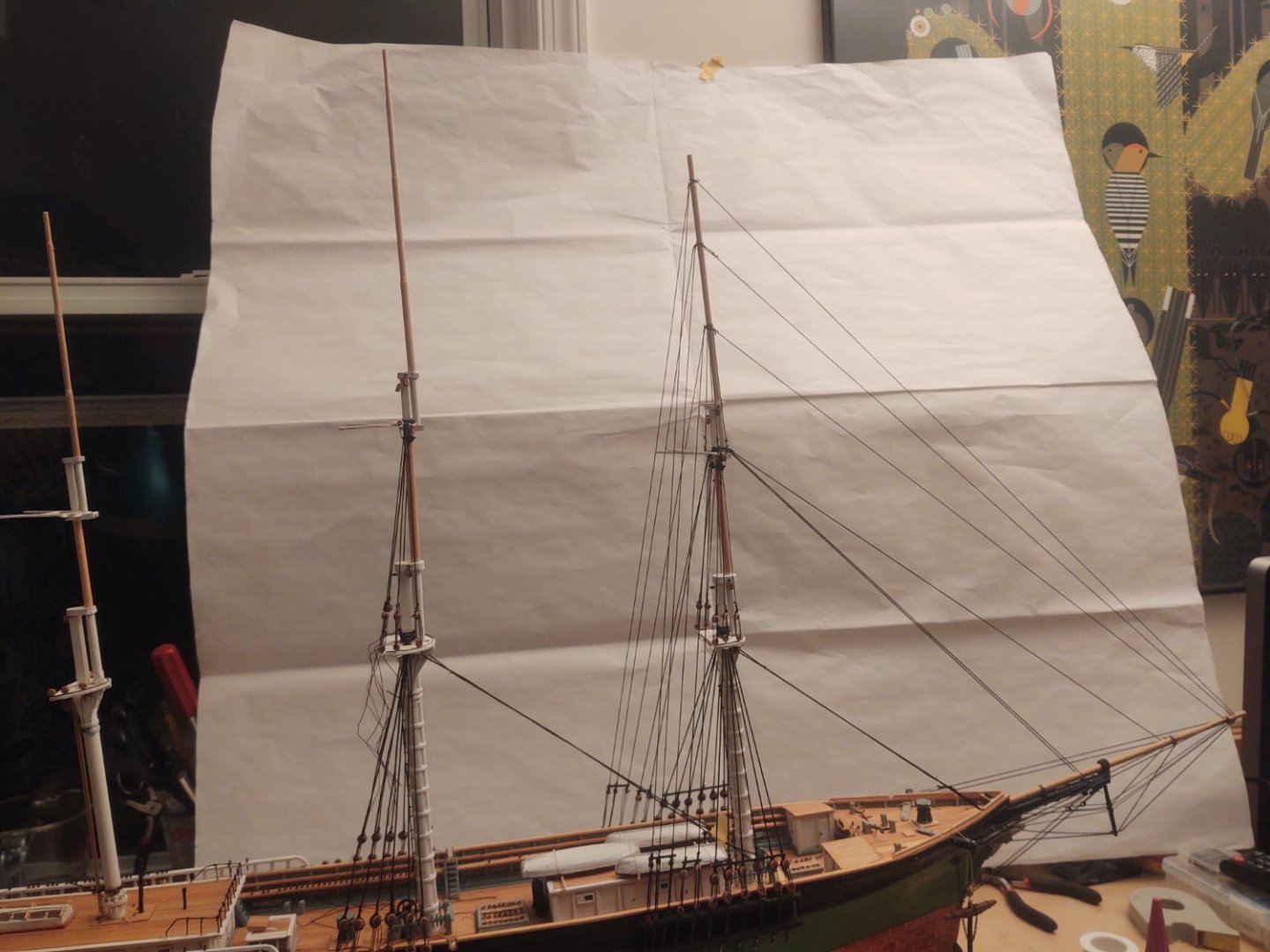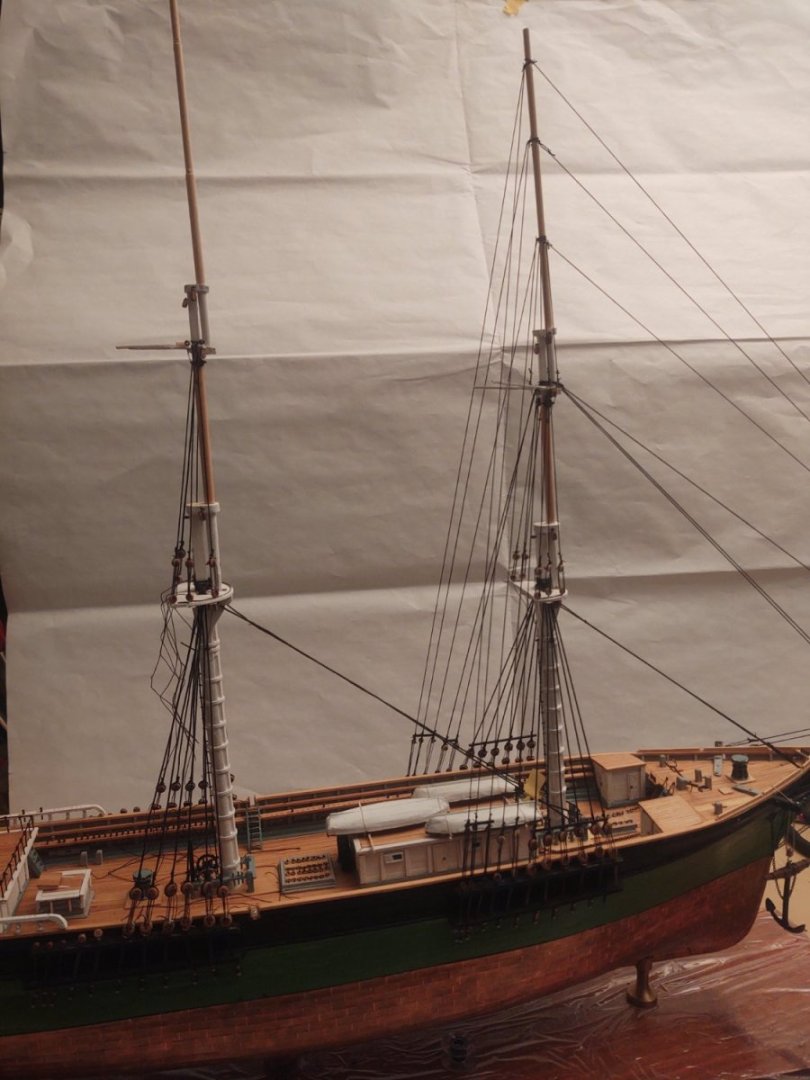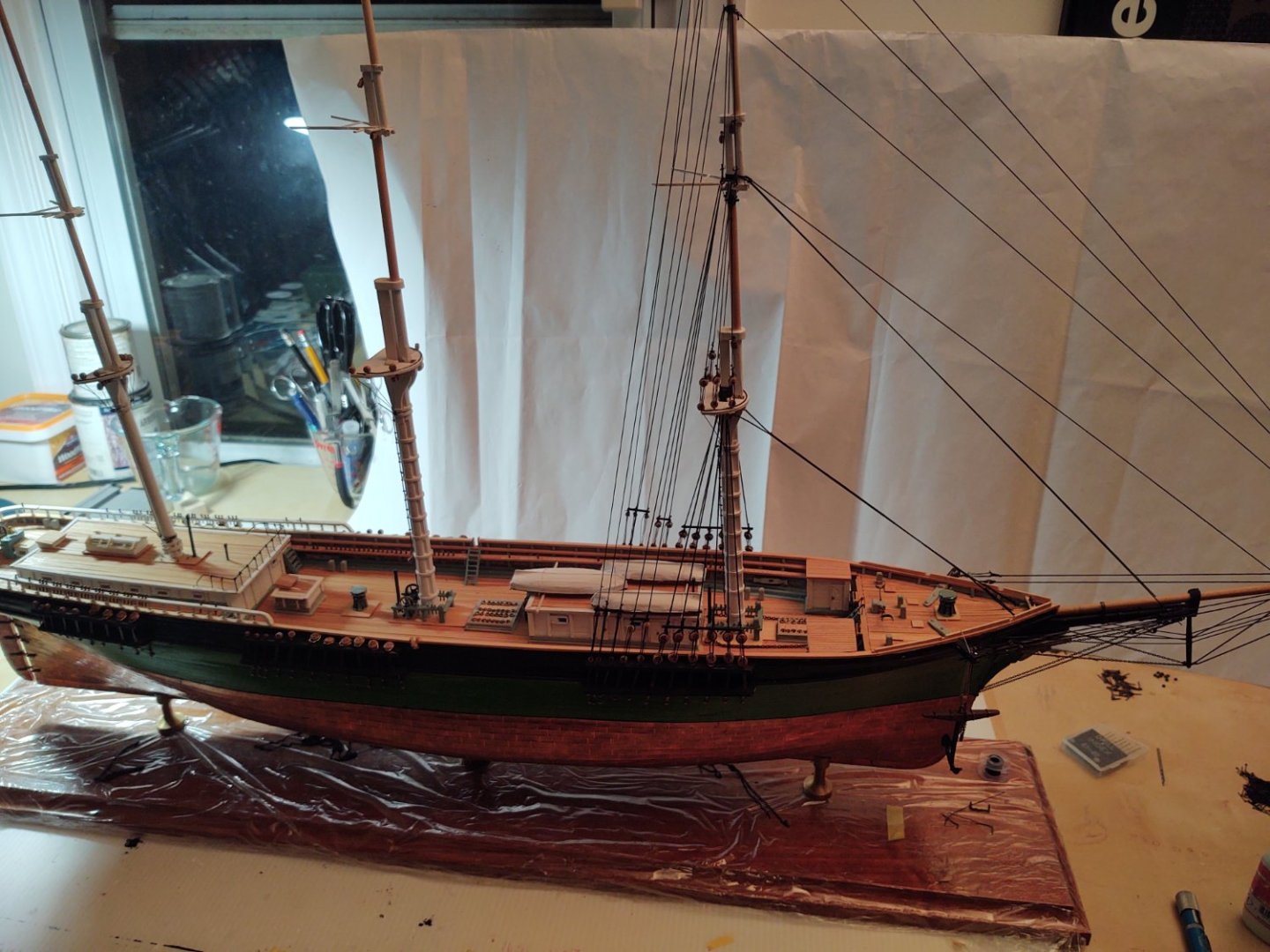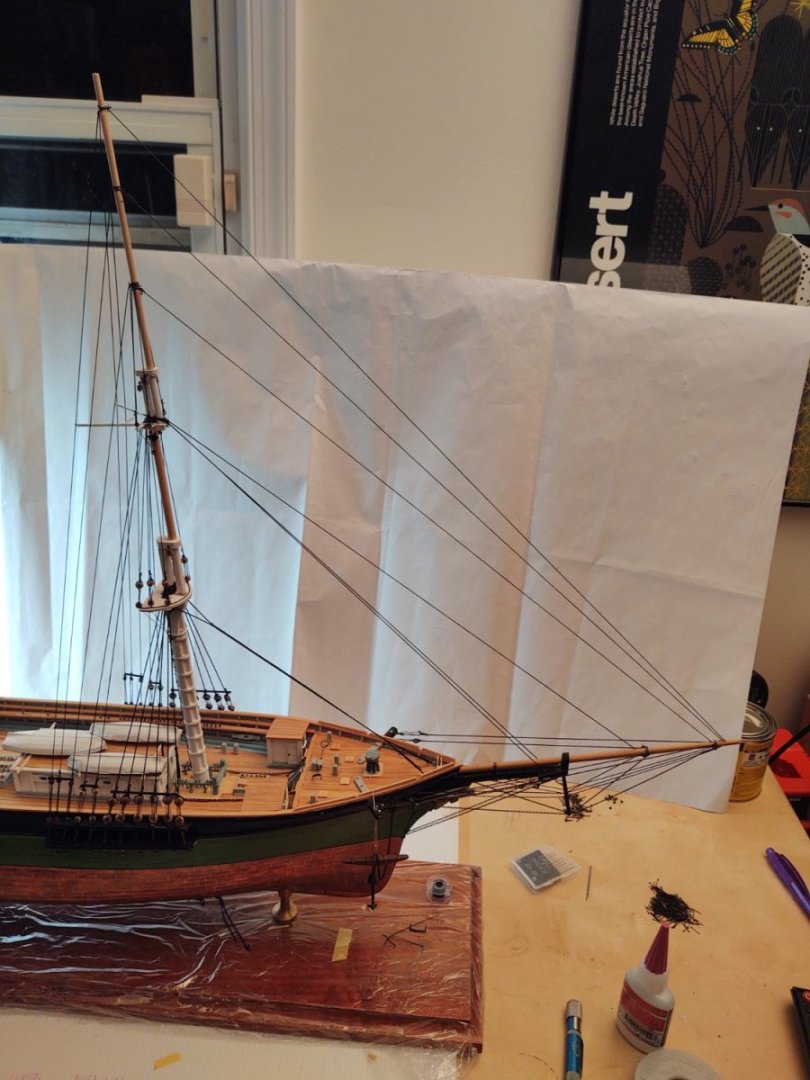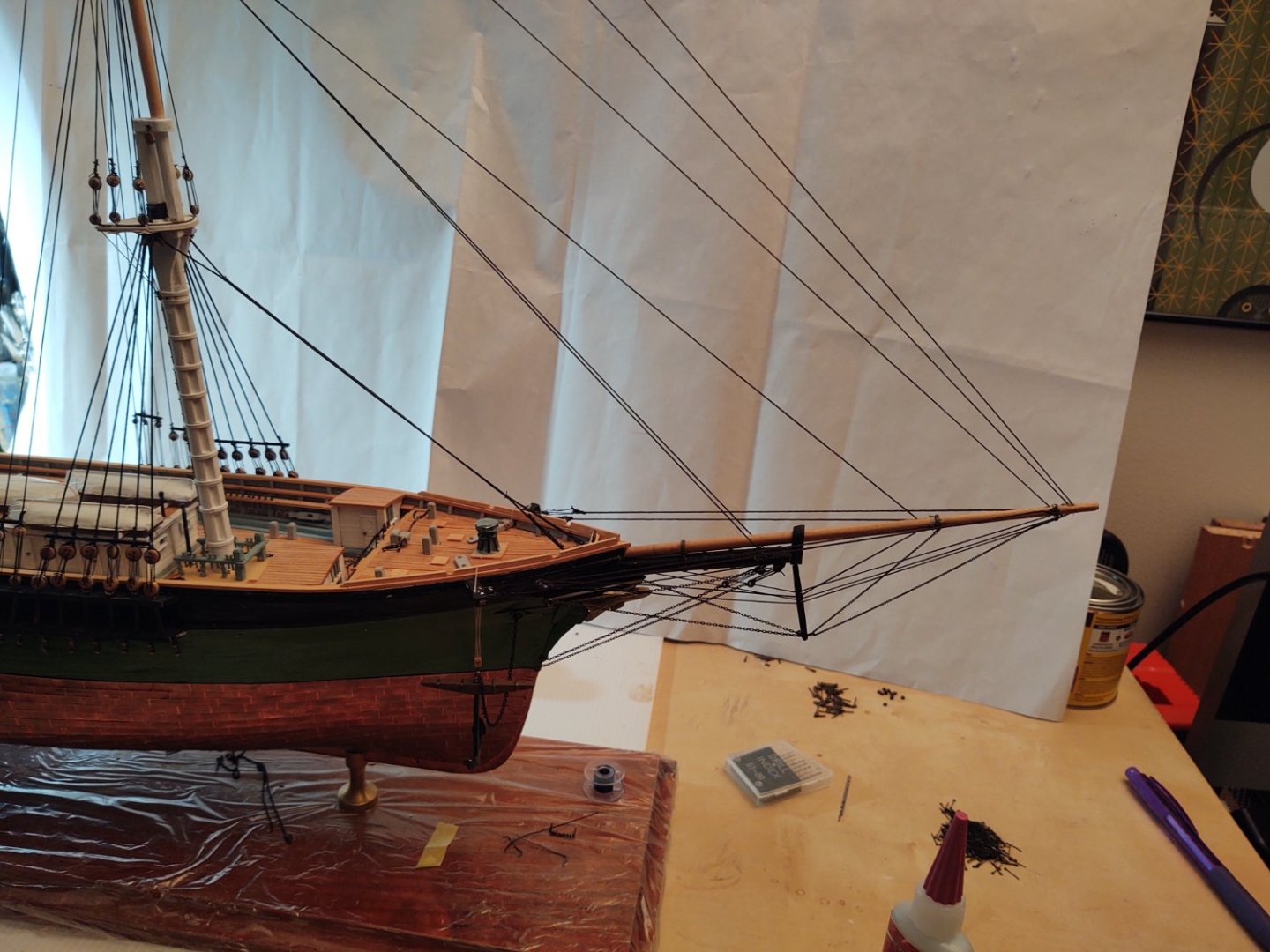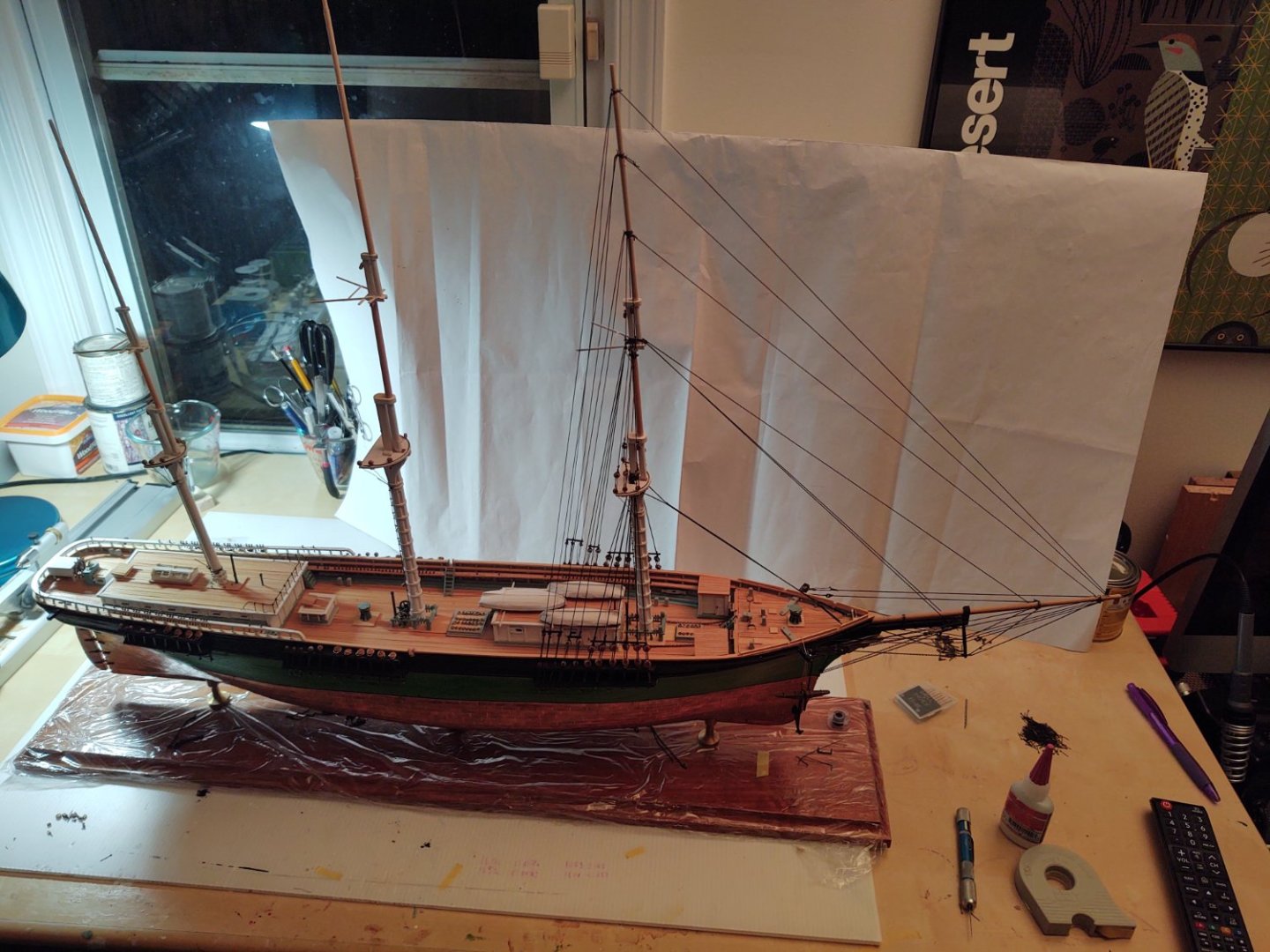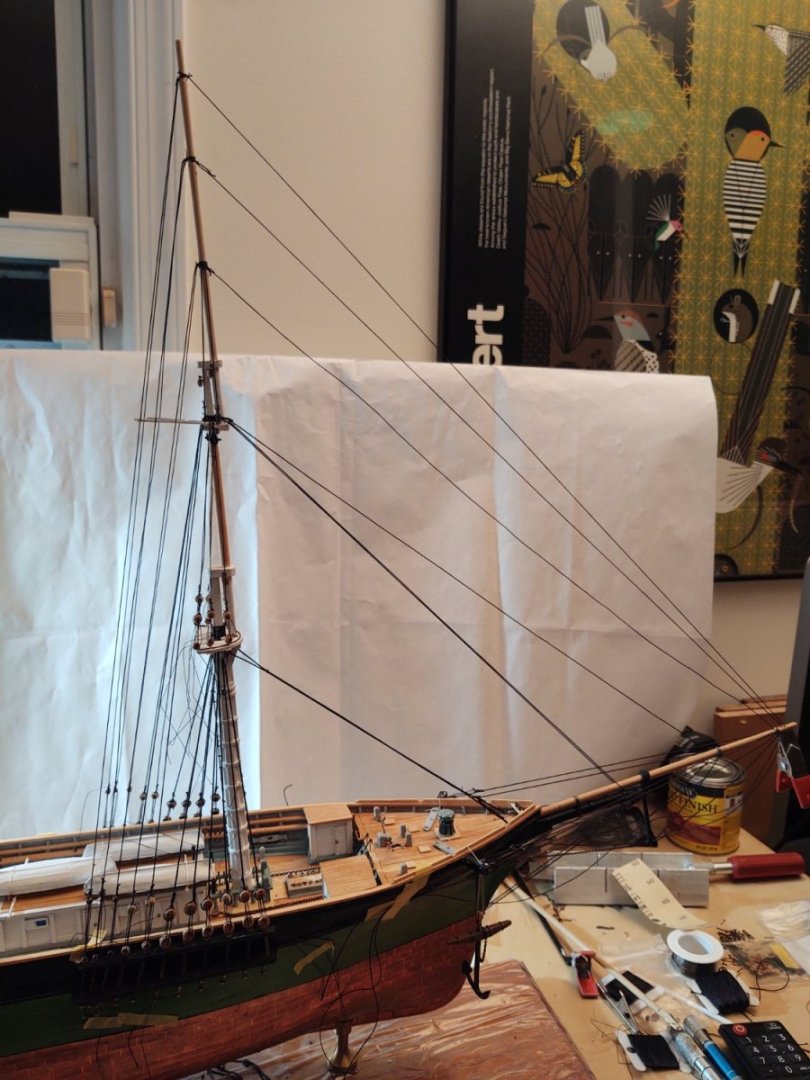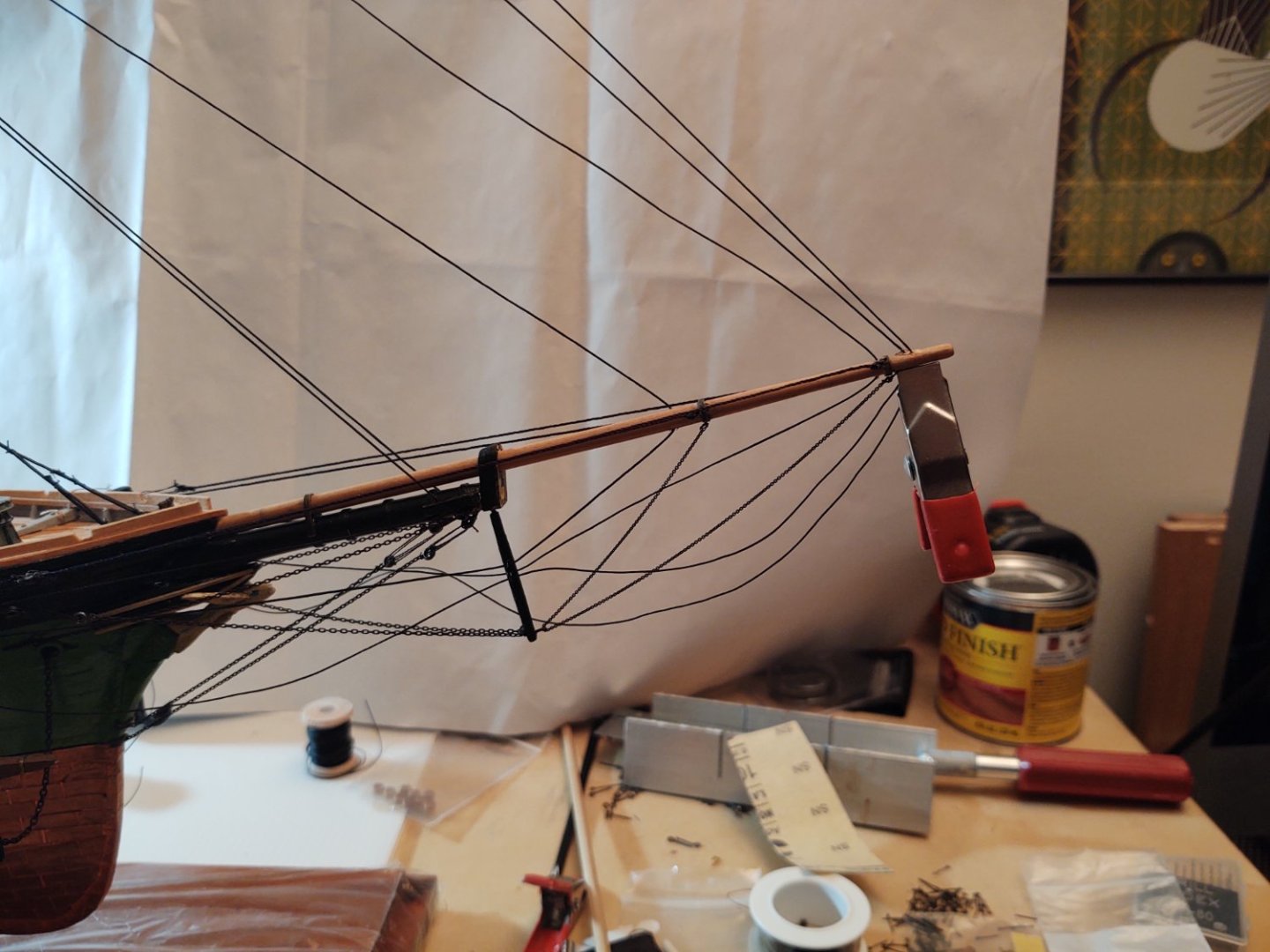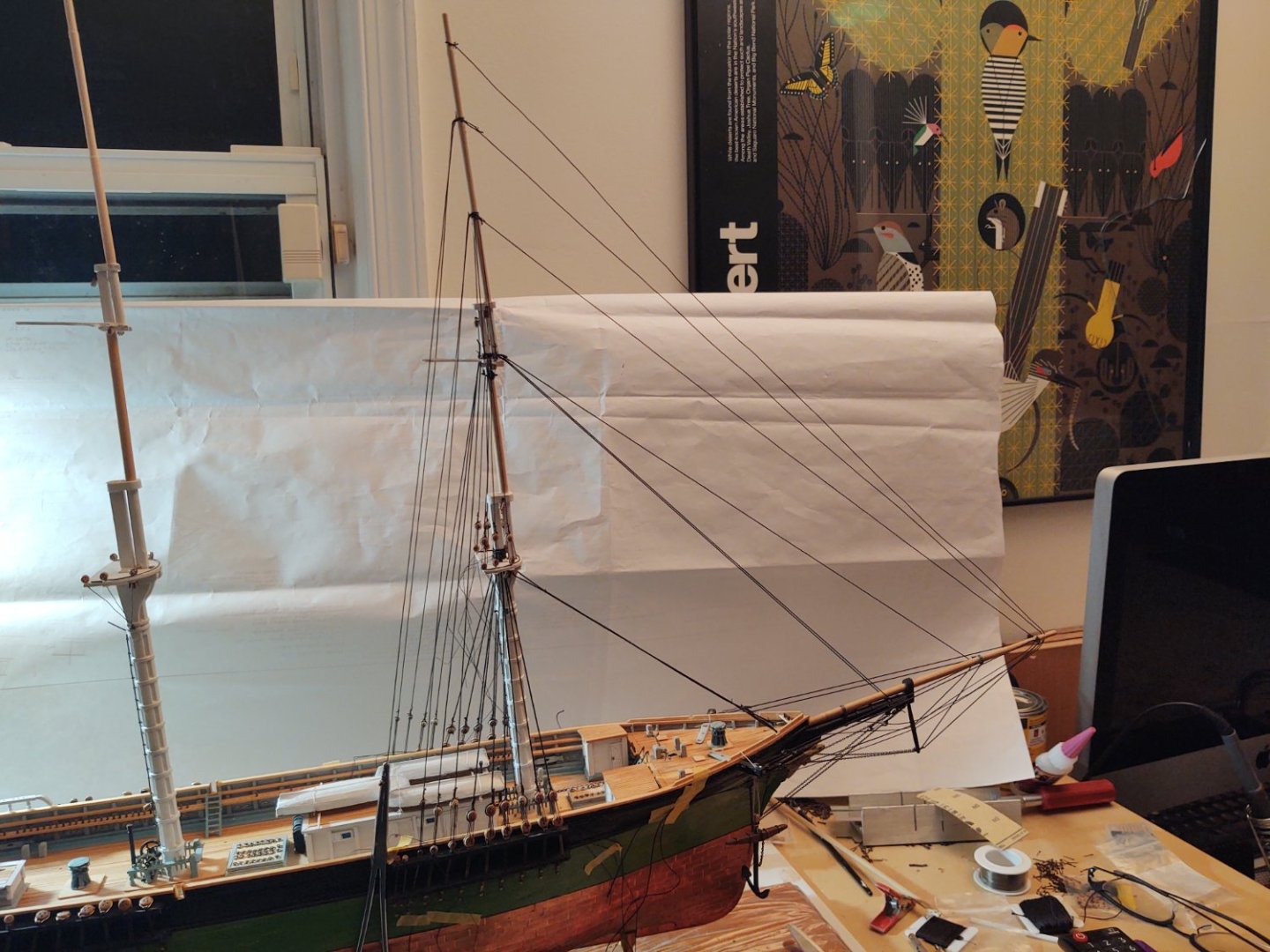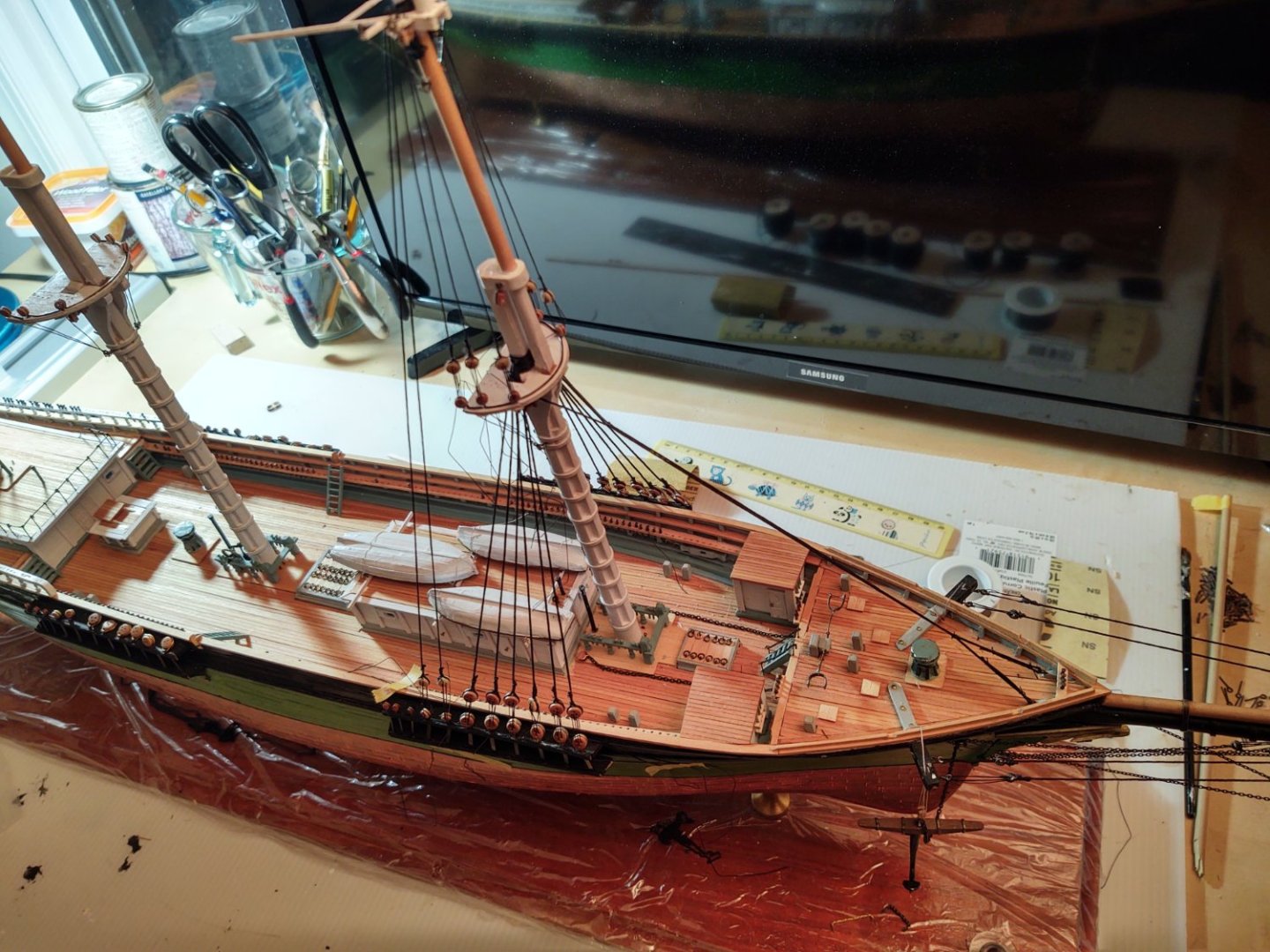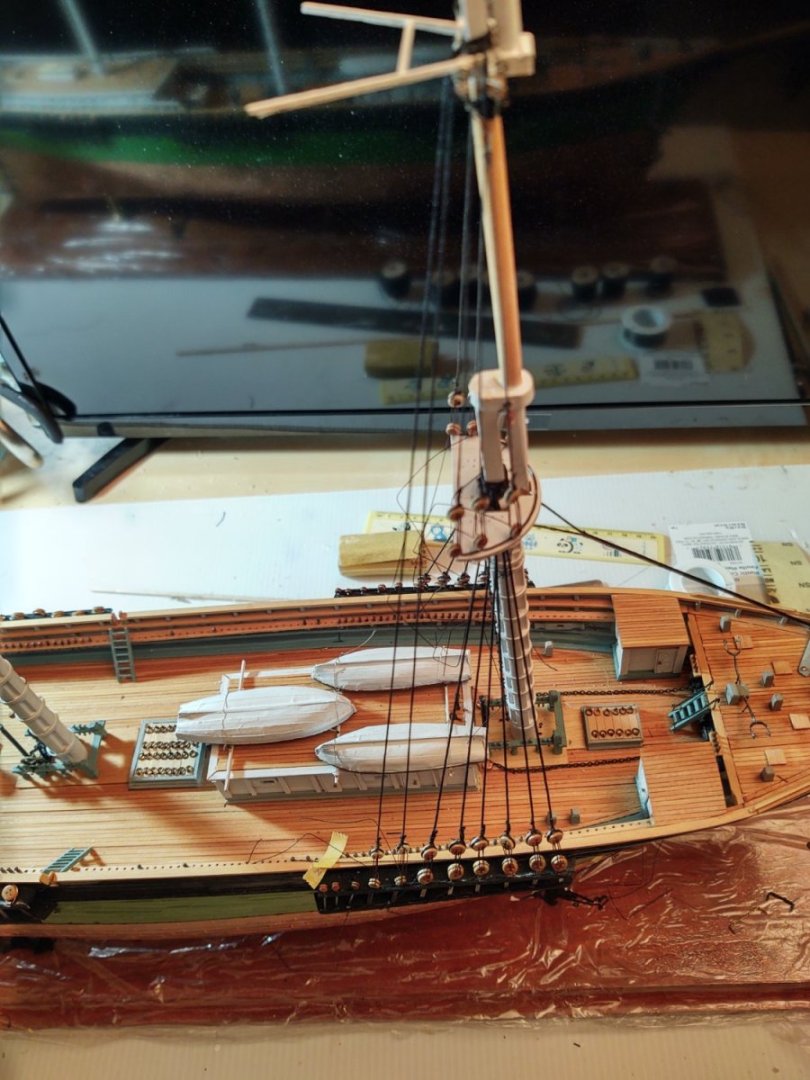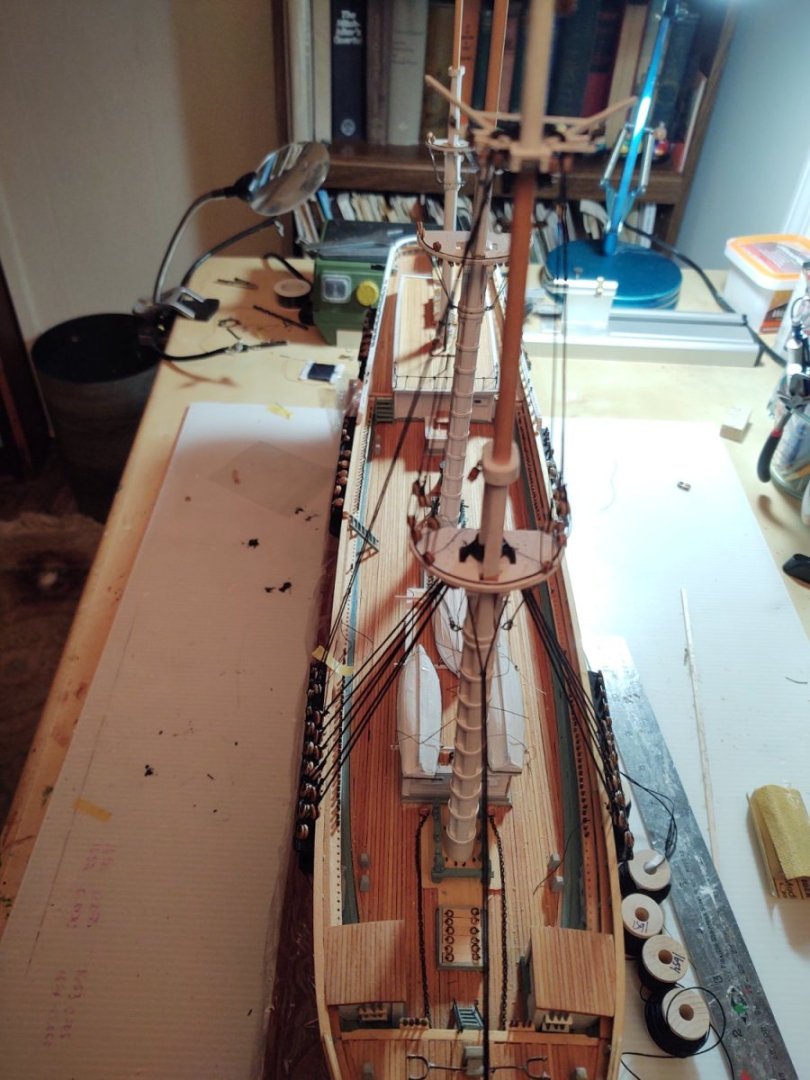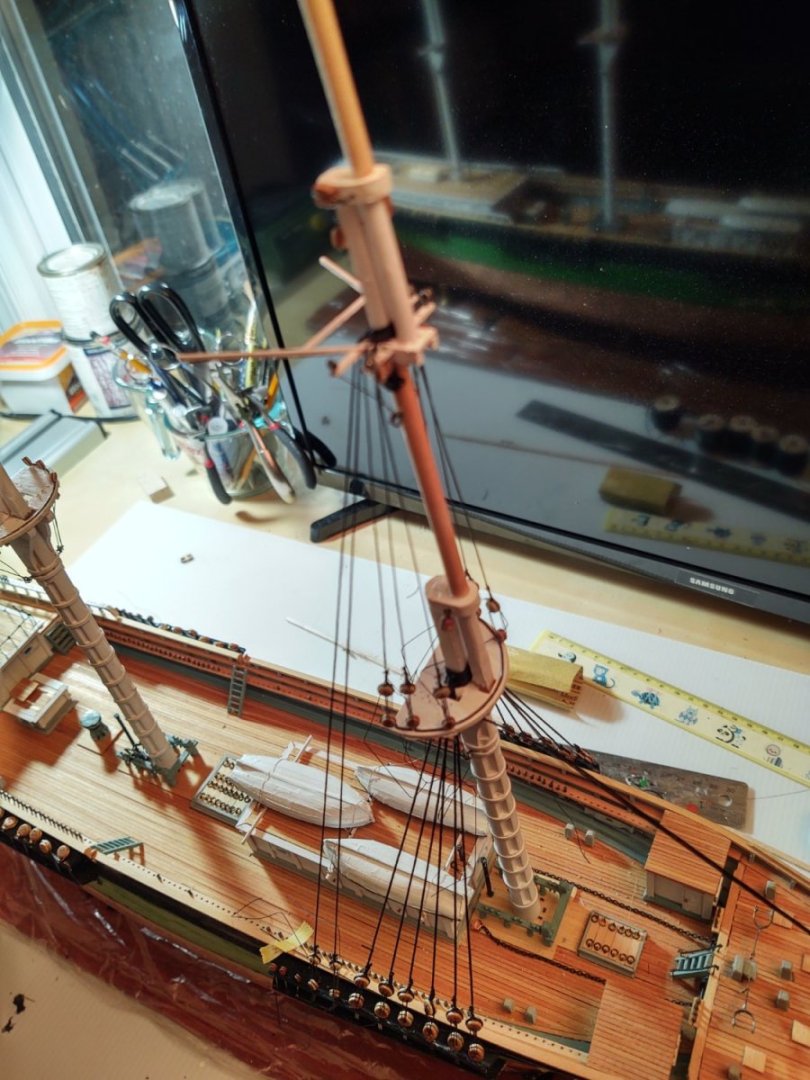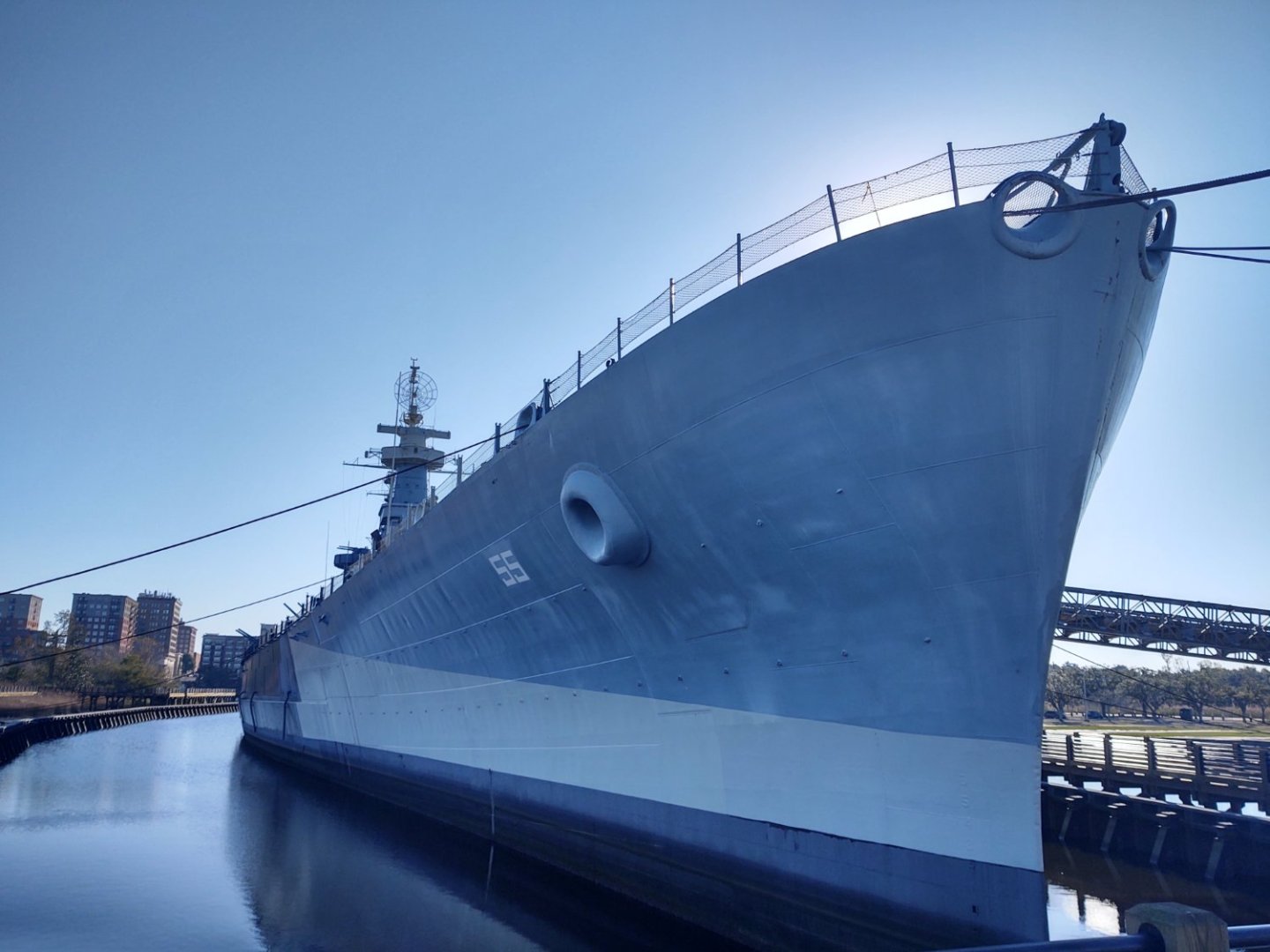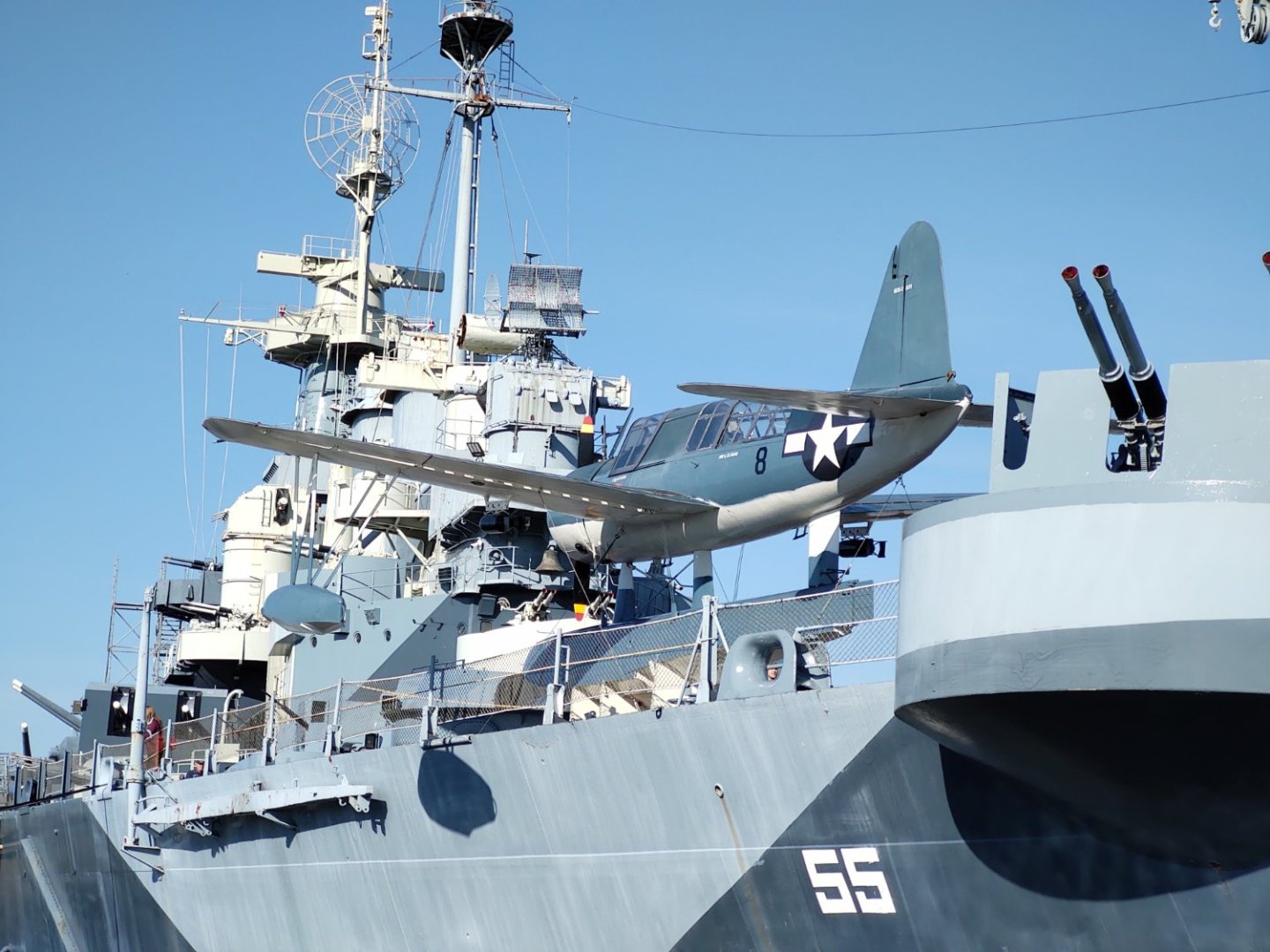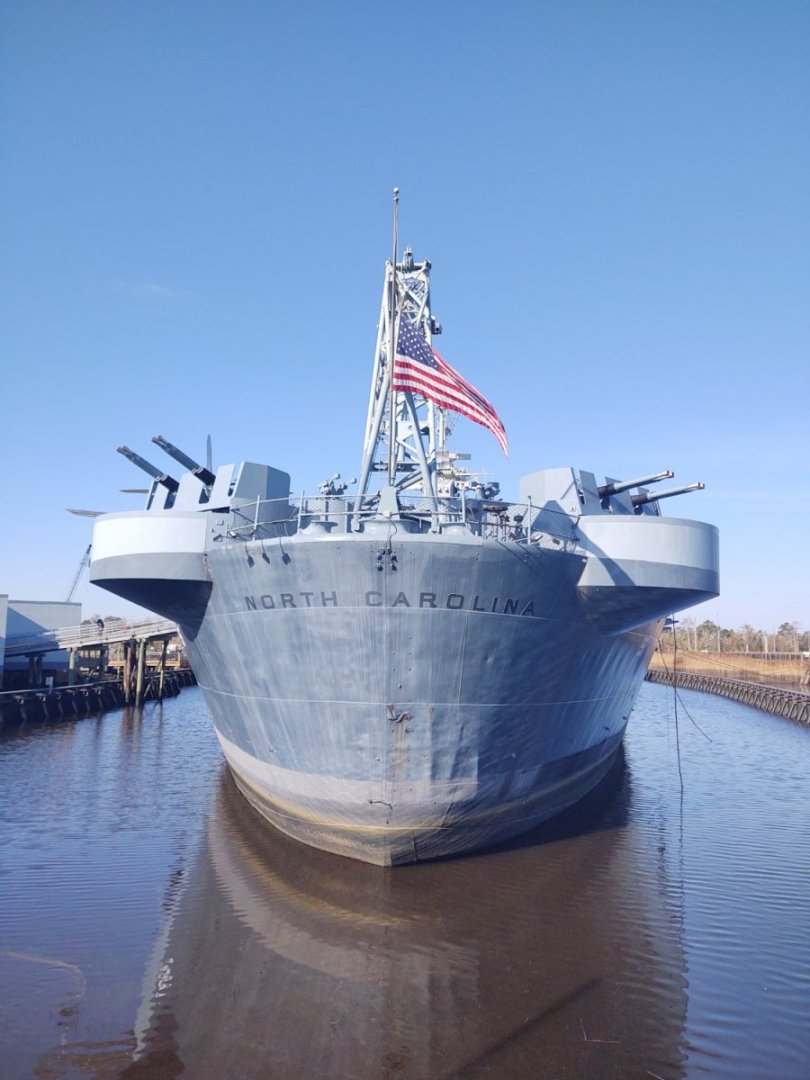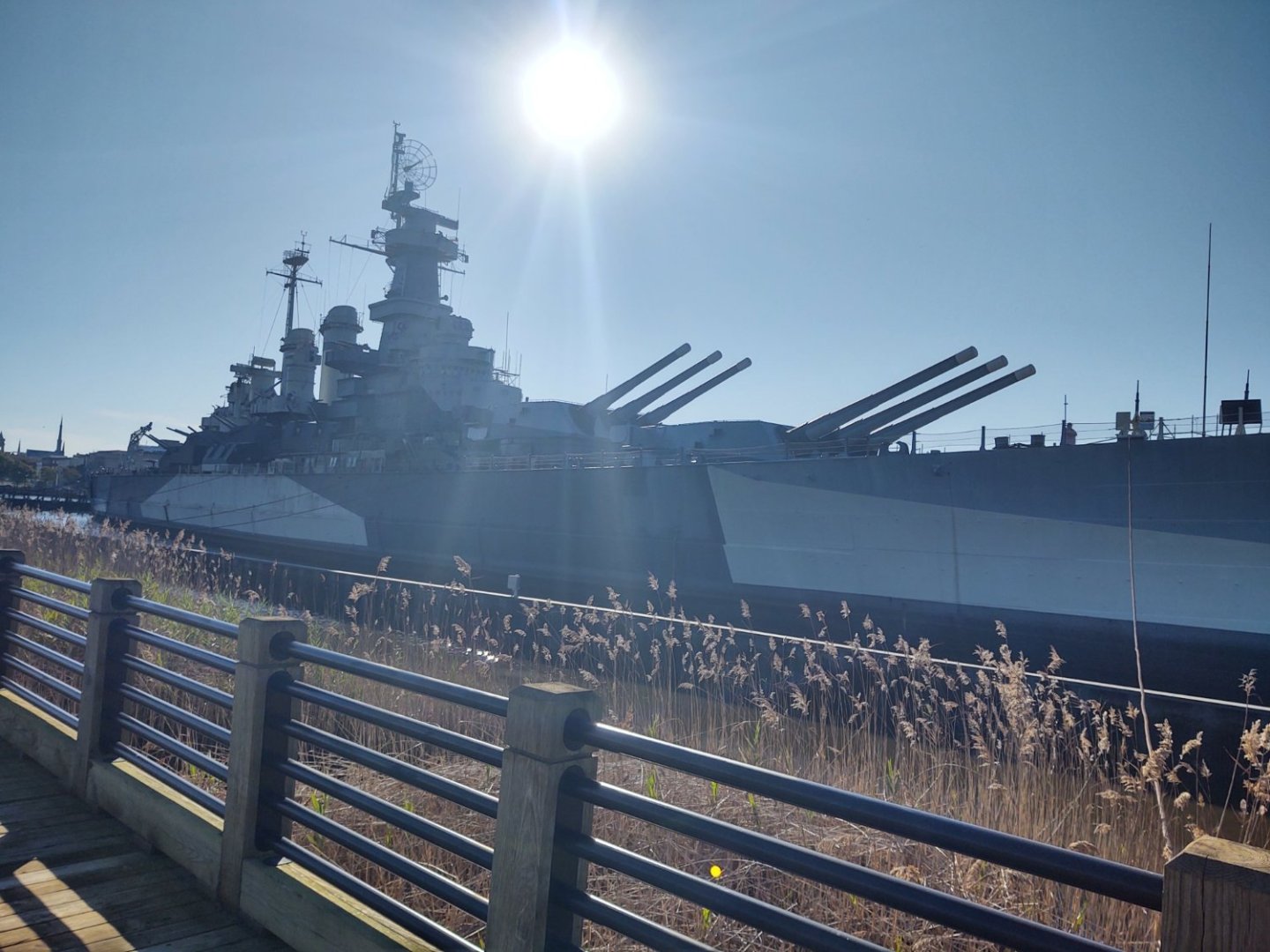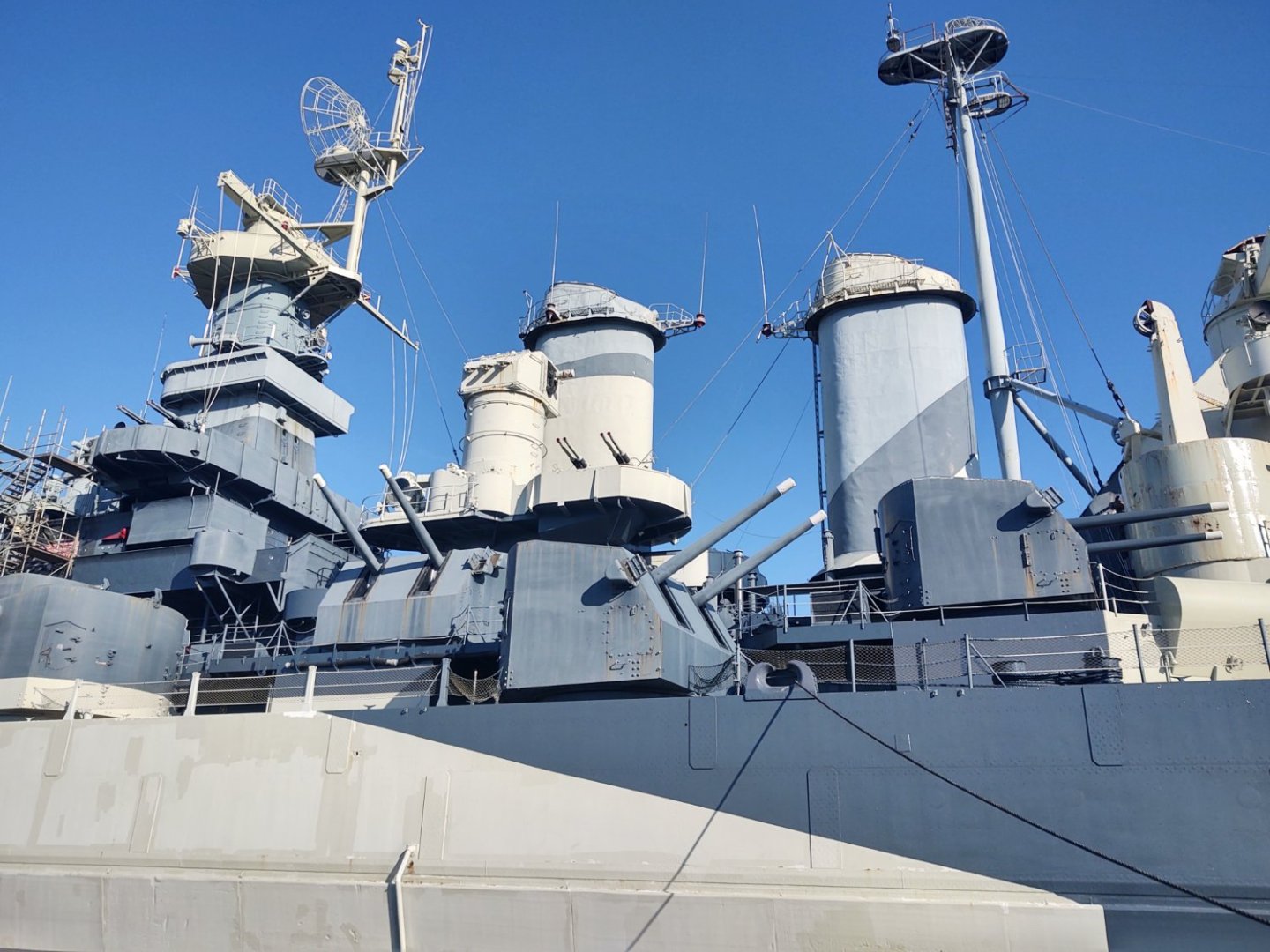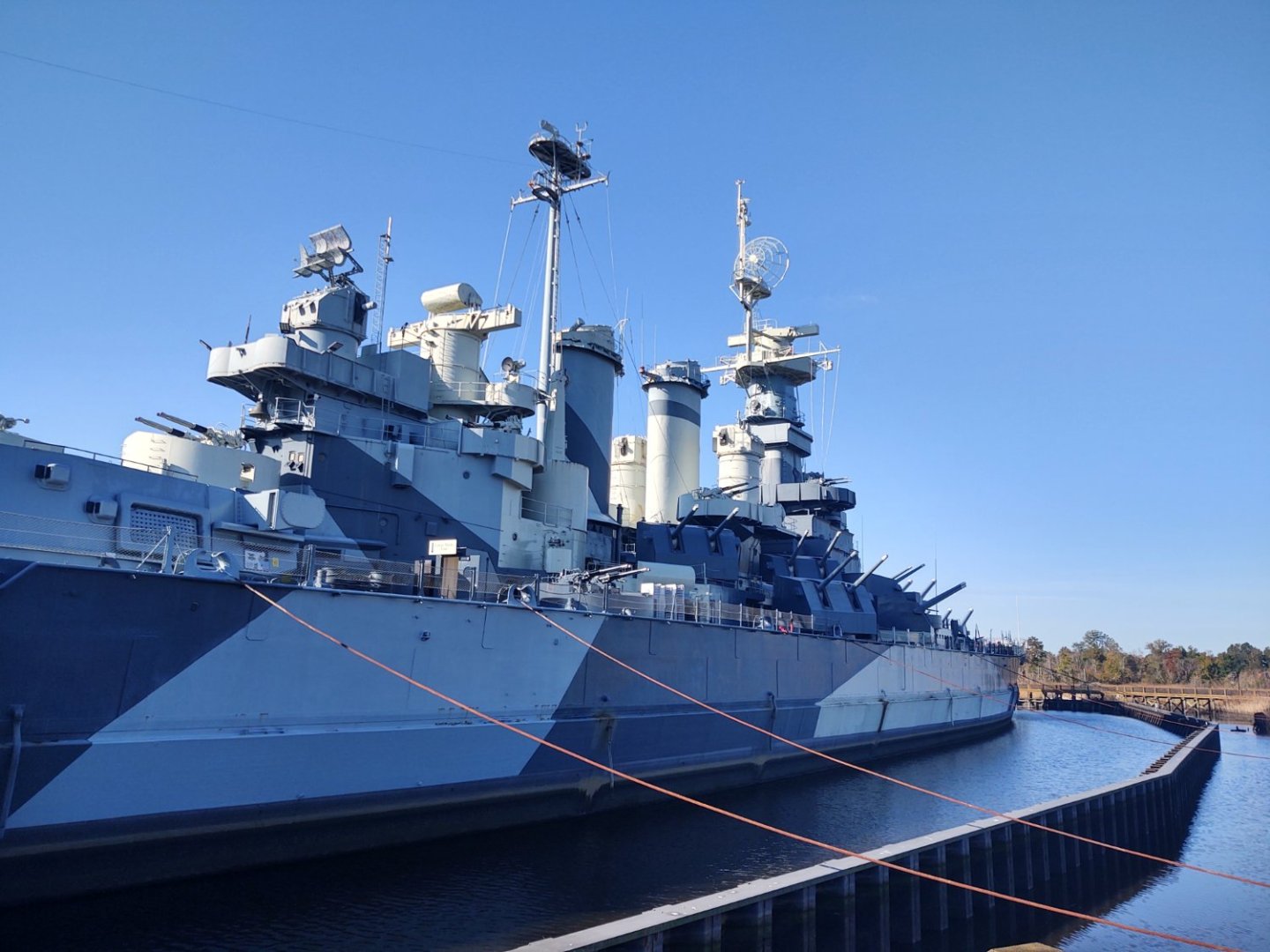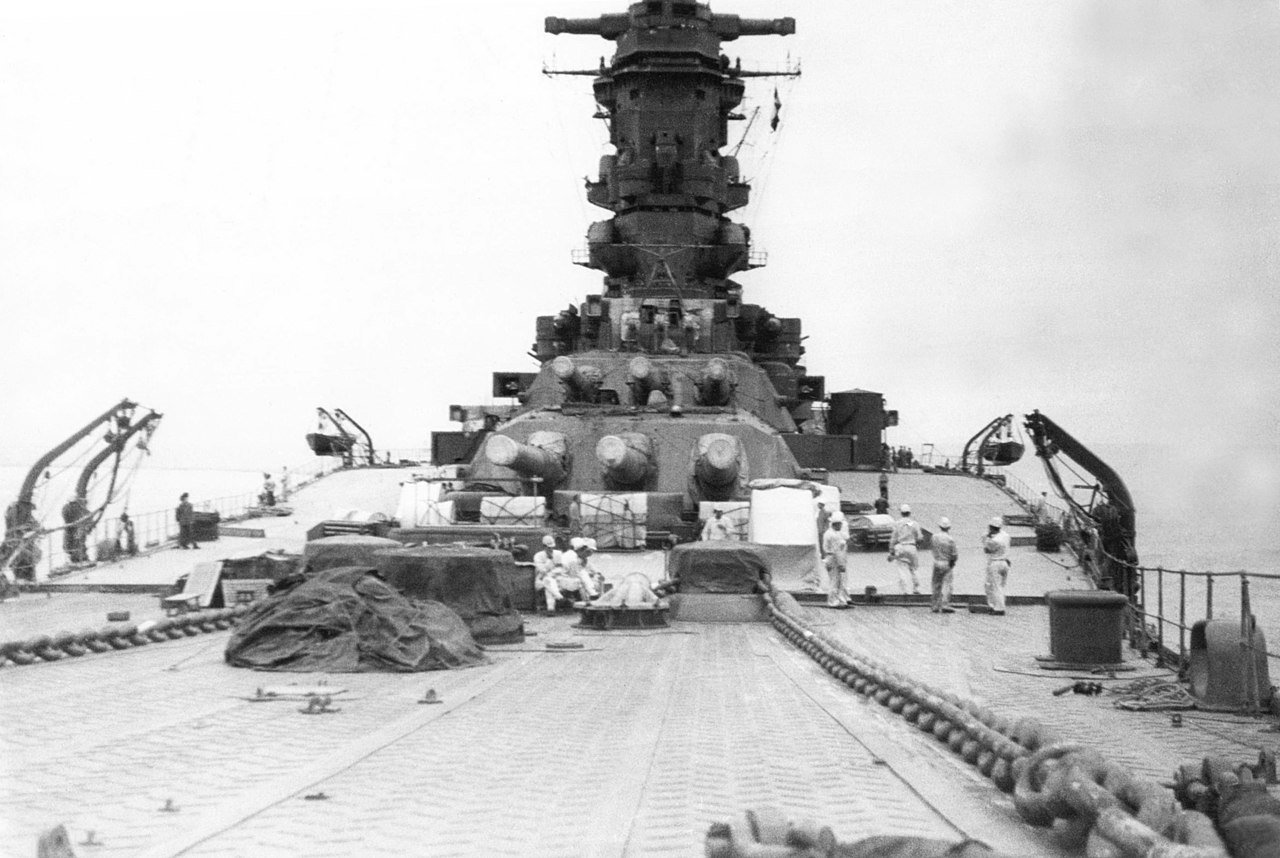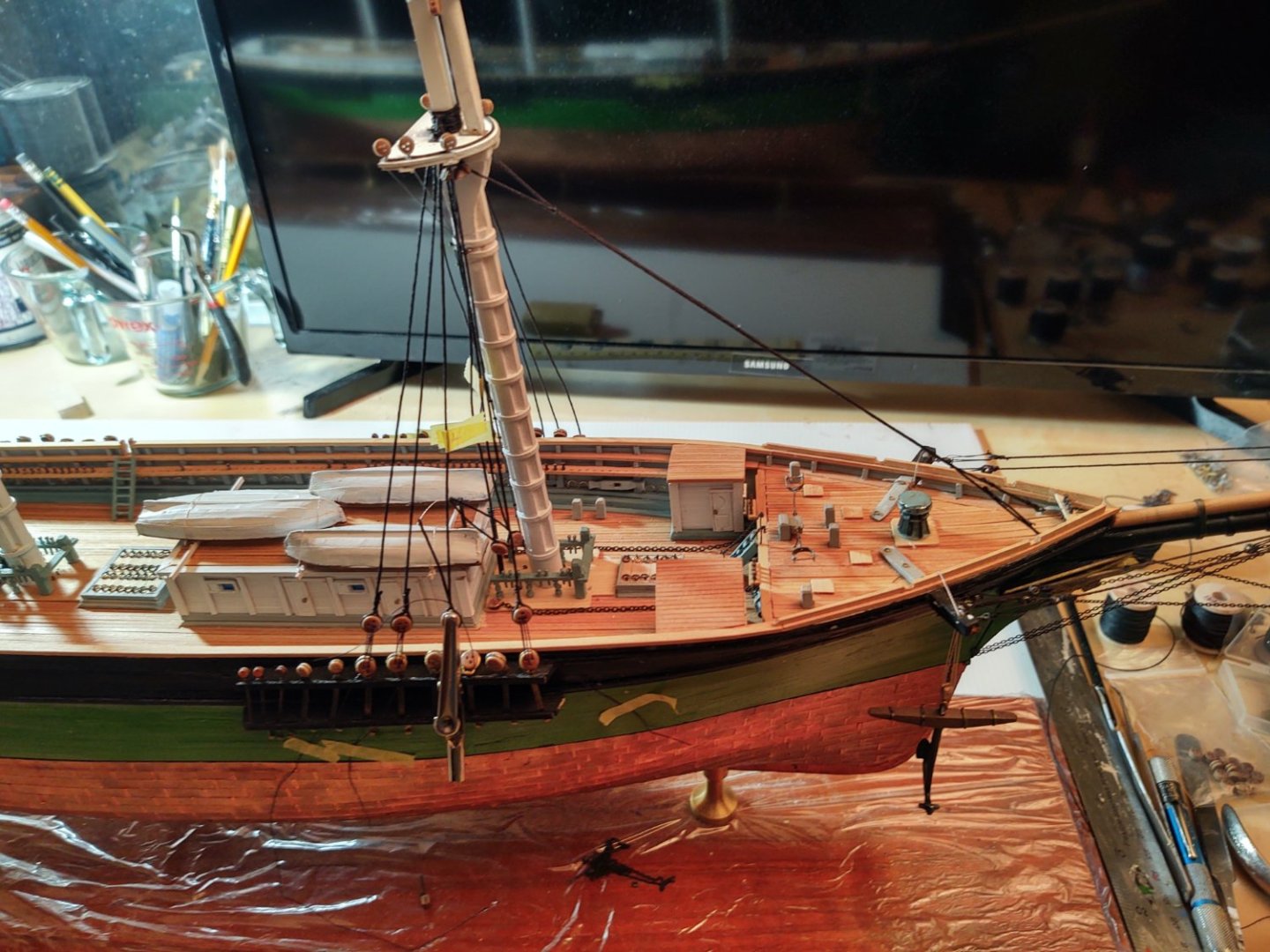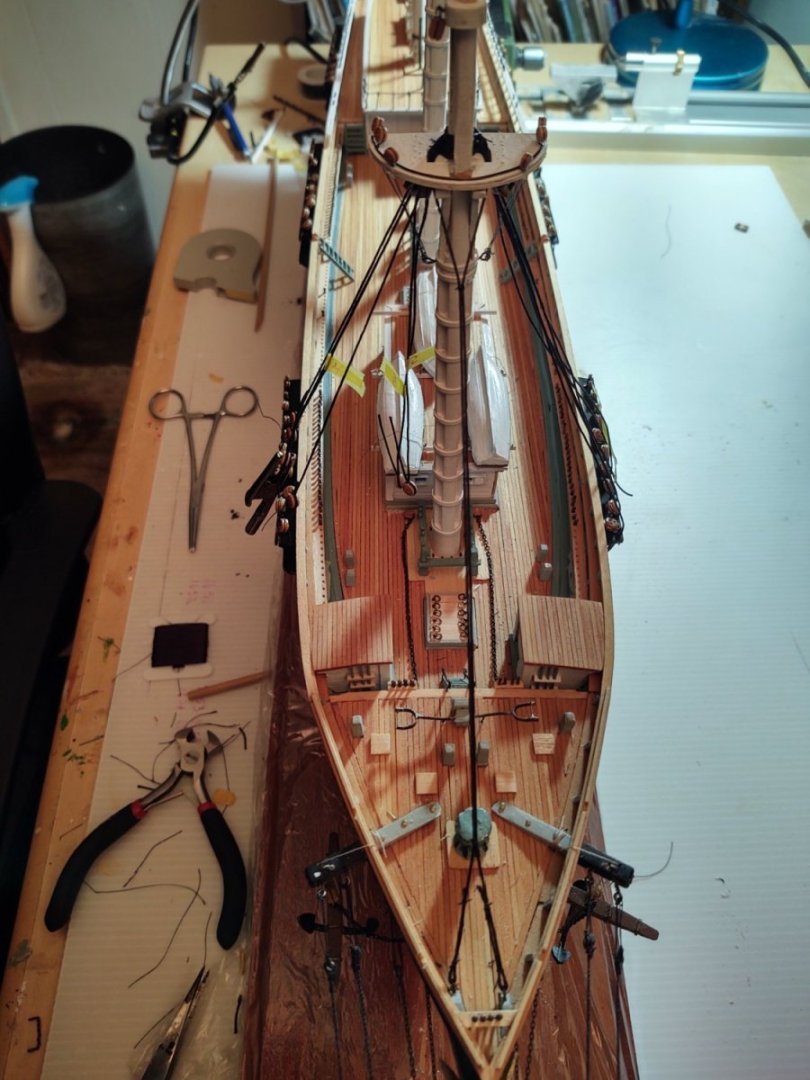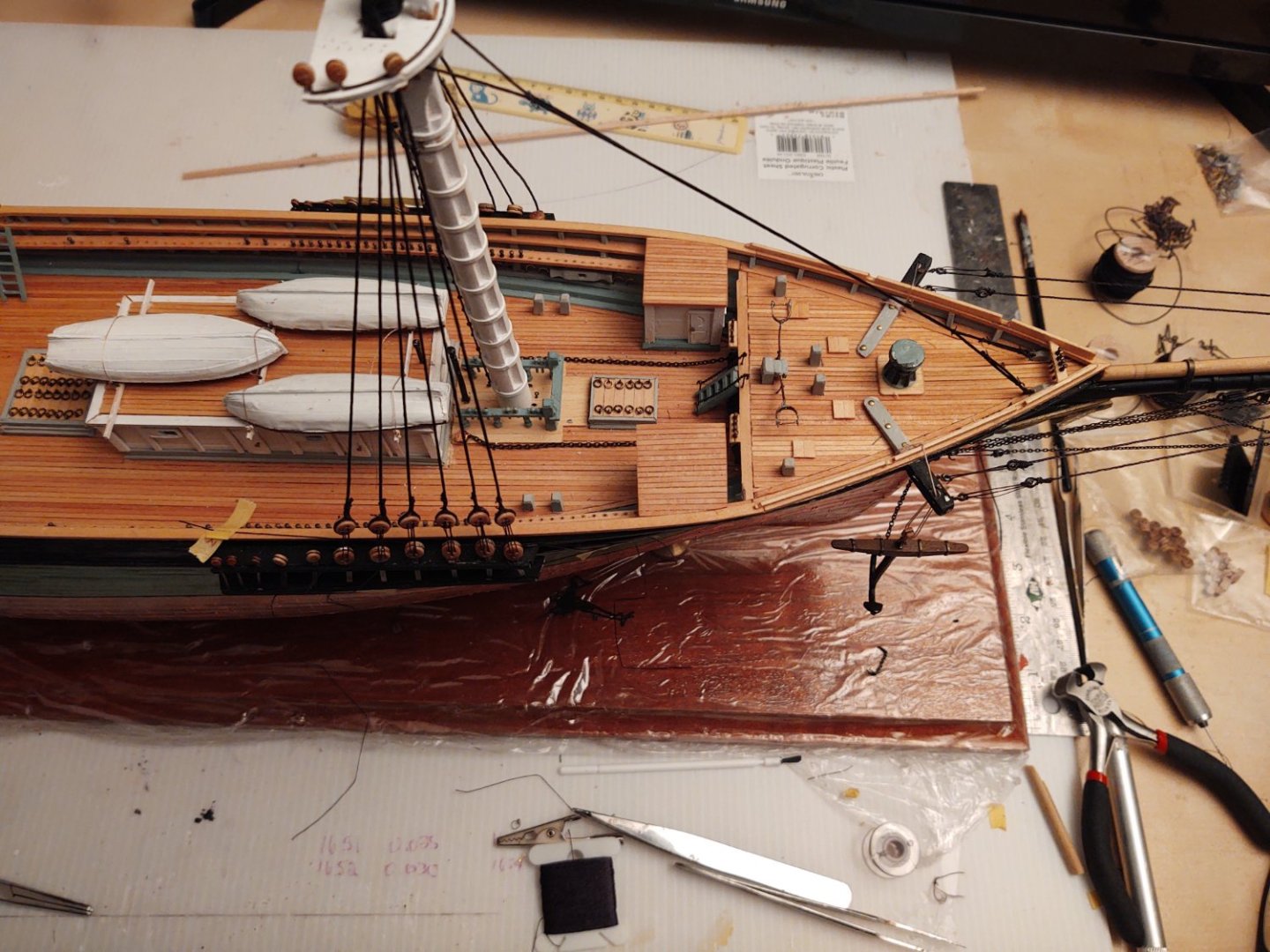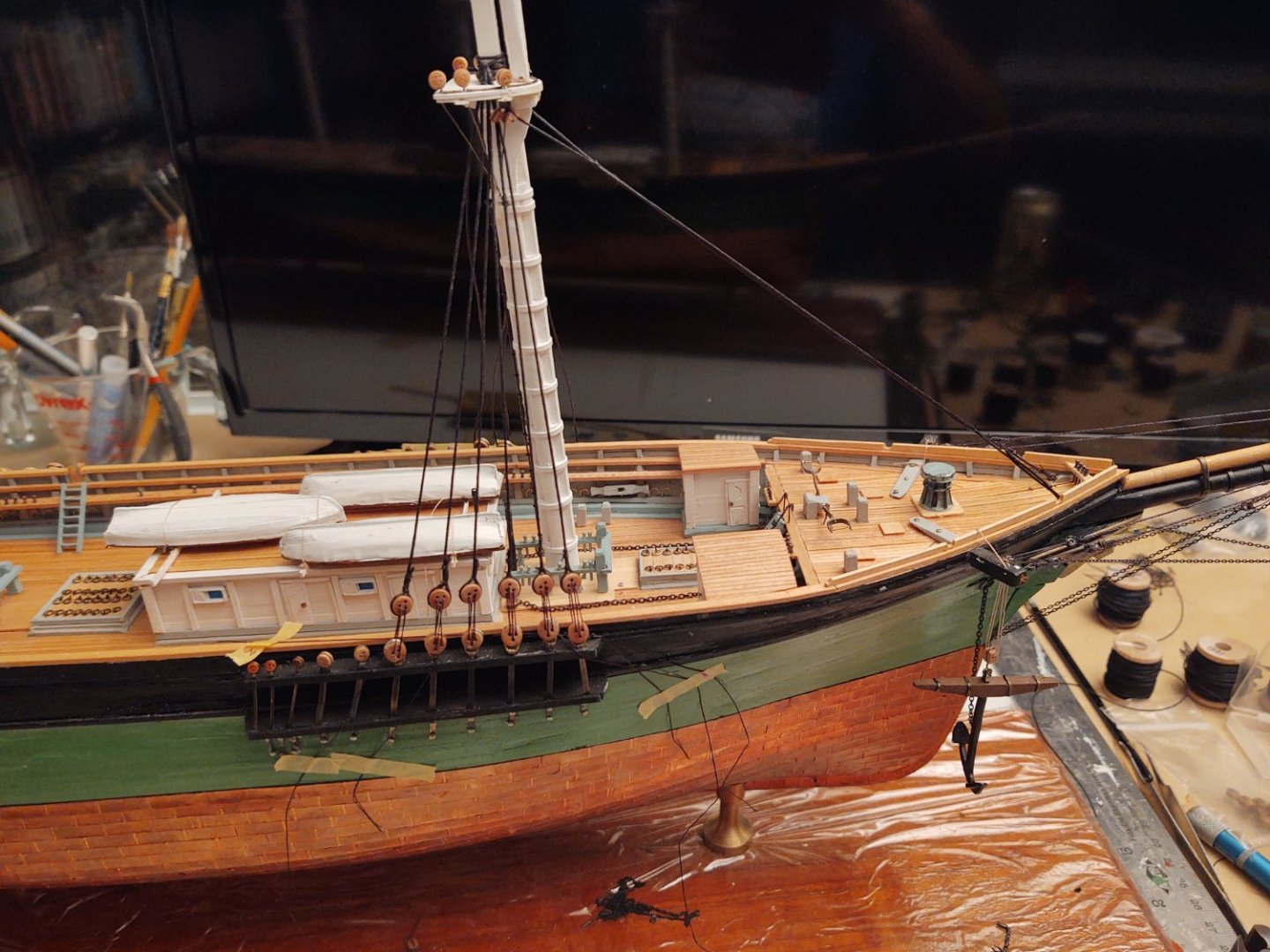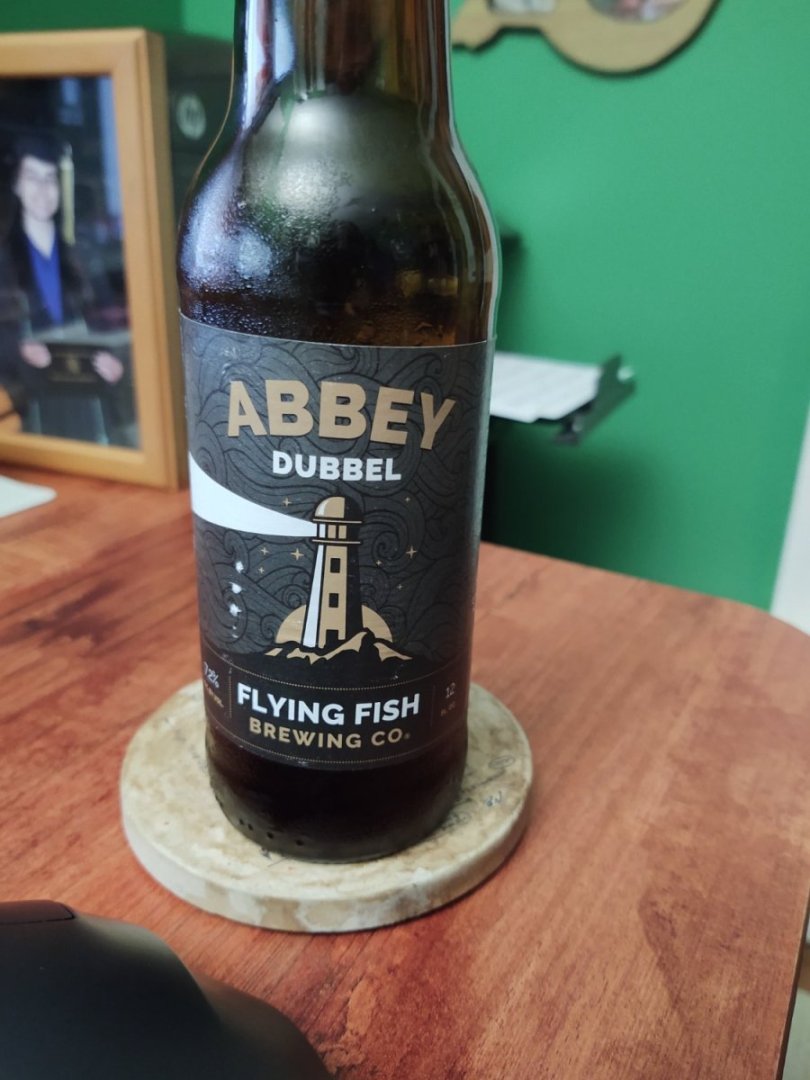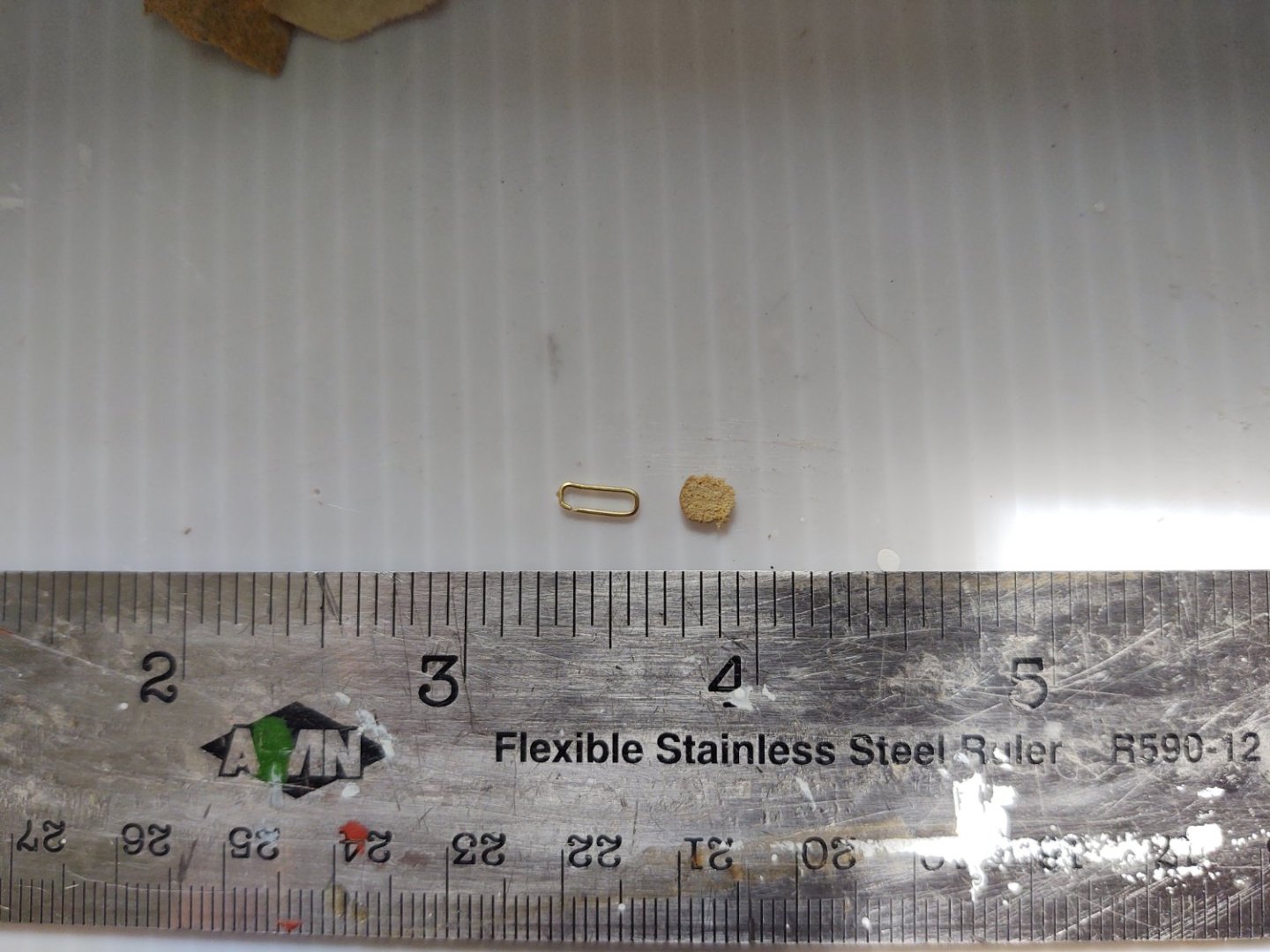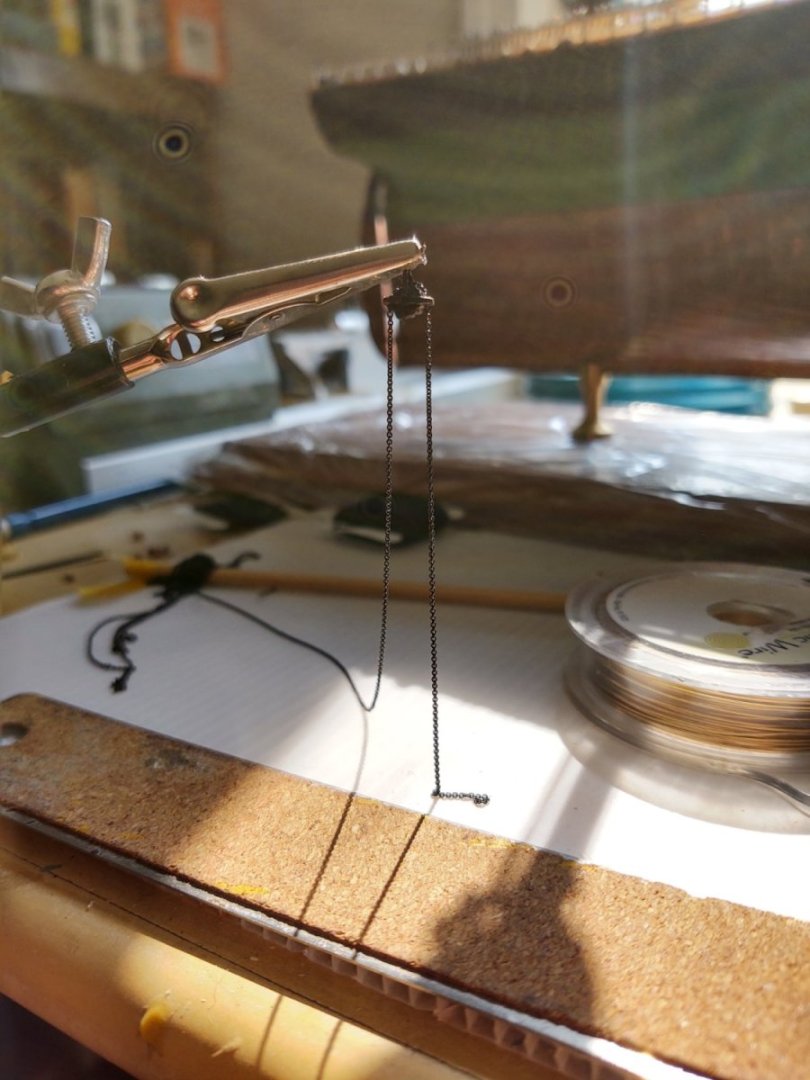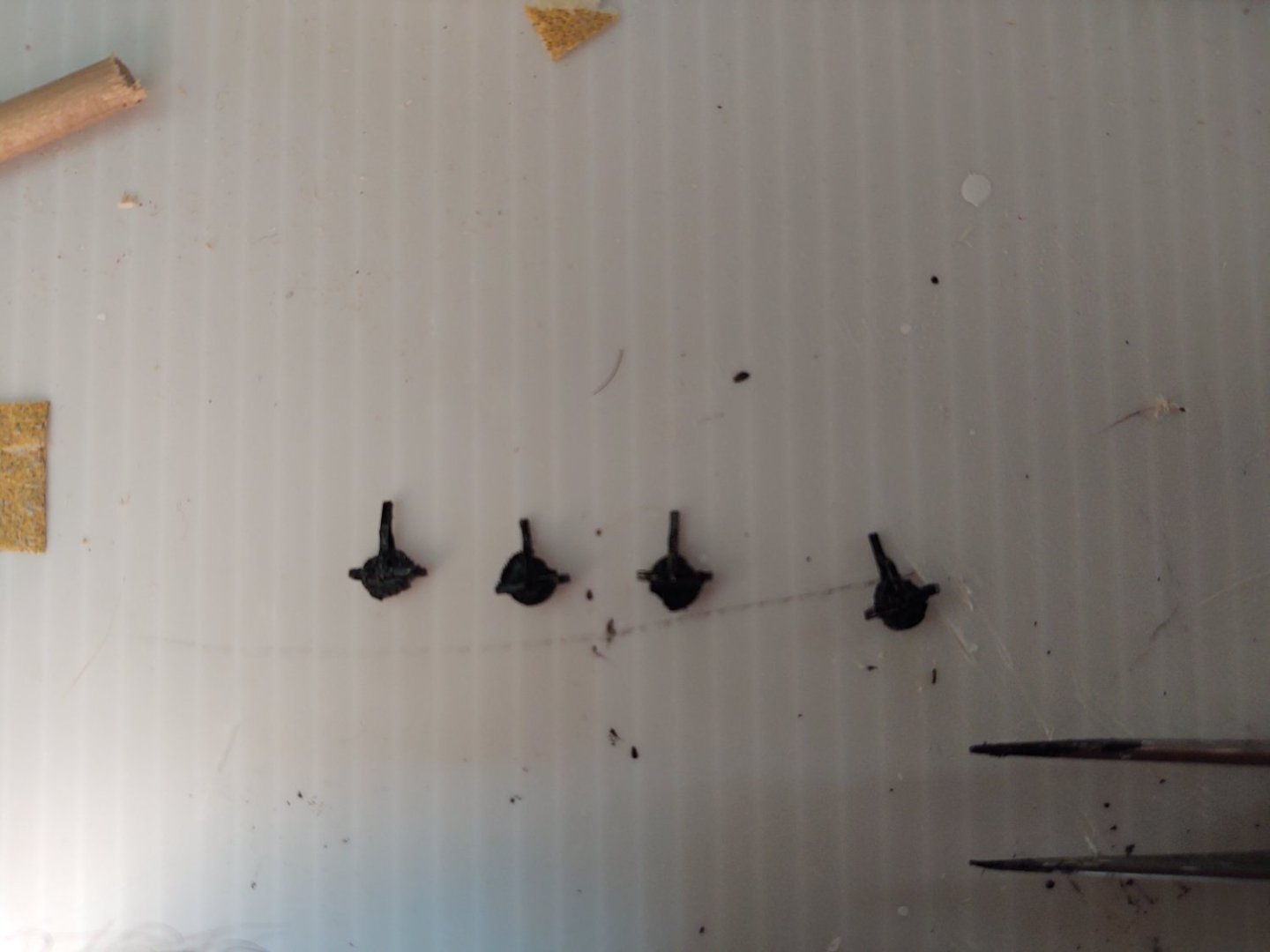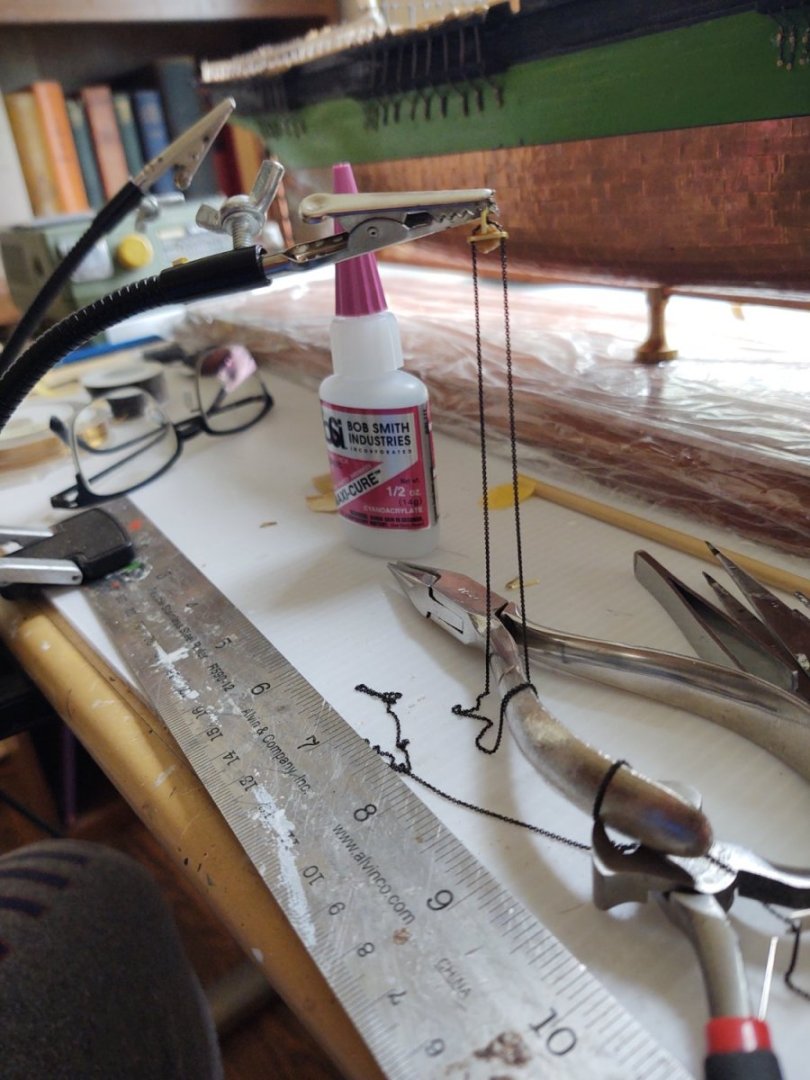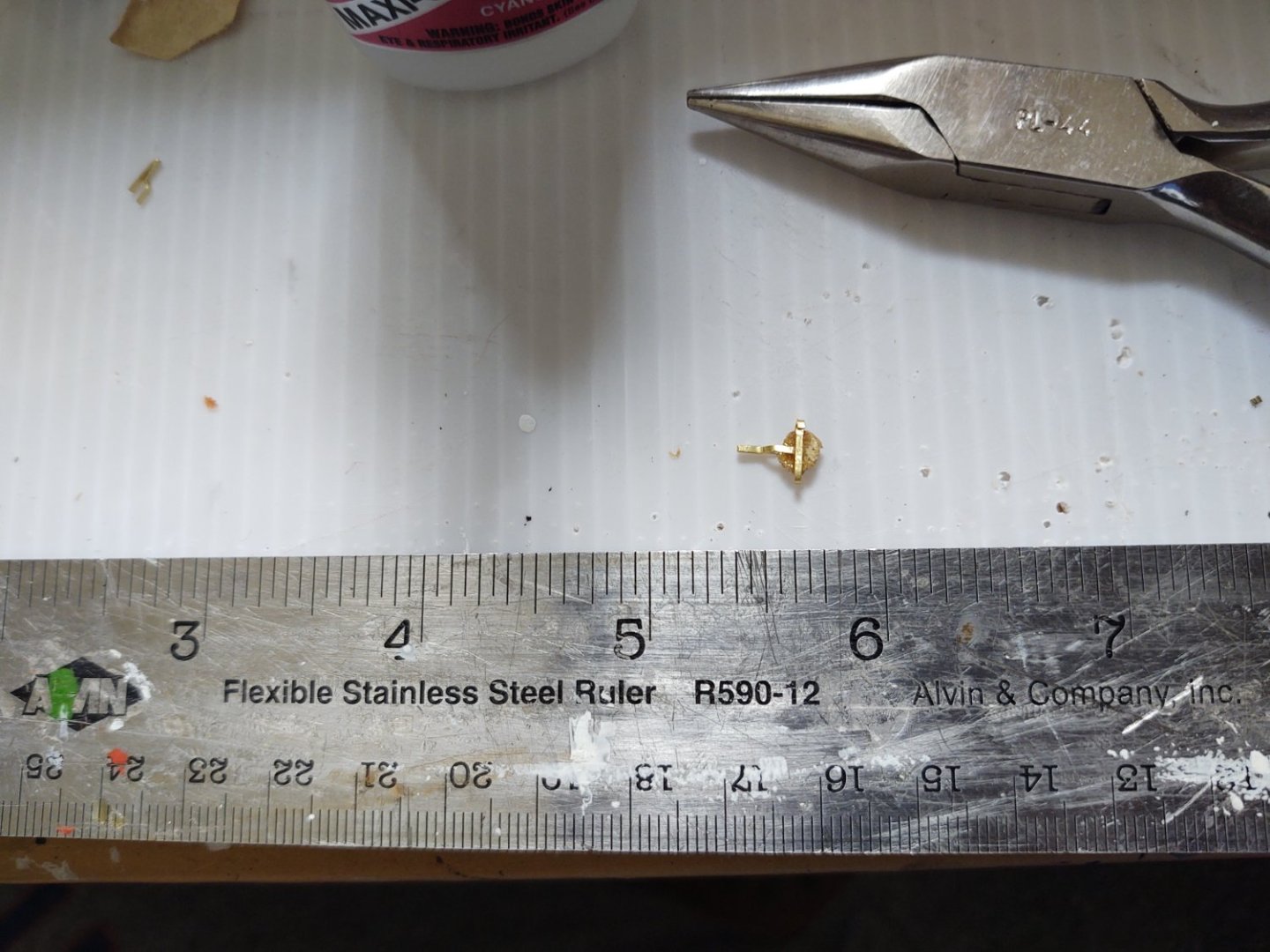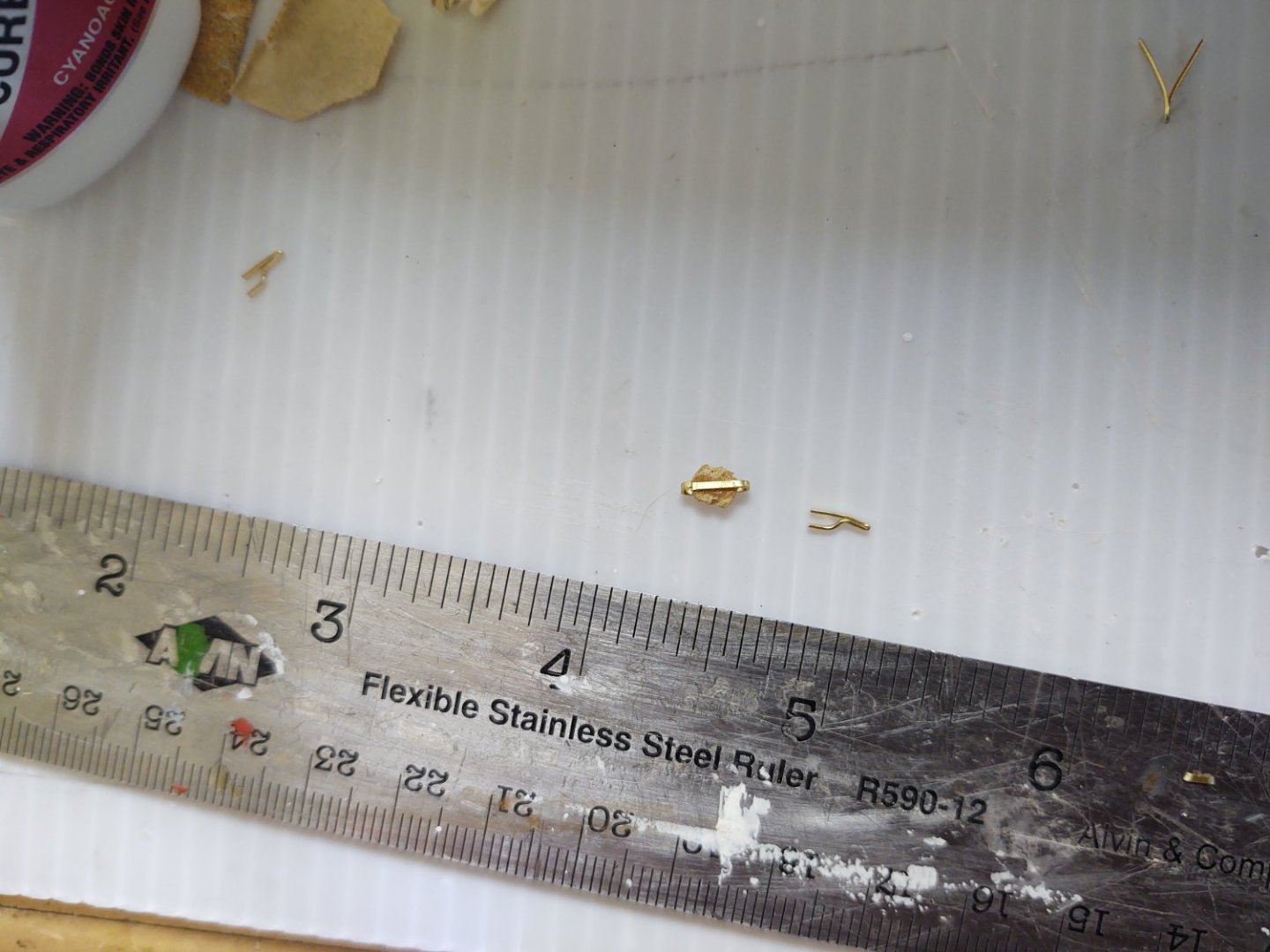-
Posts
712 -
Joined
-
Last visited
Content Type
Profiles
Forums
Gallery
Events
Everything posted by gak1965
-
Wow. You can take a dry dock tour of the Texas. Pretty awesome. https://battleshiptexas.org/drydock/
-
Well, it's been 12 days since my last update. I wished I could say that I have made massive progress, but I think I will have to settle for some progress. At this point, all of the mainmast futtock shrouds are in place, and I've rigged (but not anchored the lanyards) of the lower and topmast shrouds and the main forestay (which terminates on the foremast fife rail). As with the fore, I'm going to get all the lines in place and then tighten/anchor from the skysail down. Here are two pics of the main and foremast as things are moving along. One thing I am thinking about doing before starting the 'fun' of the ratlines is attaching the tackles (I think mostly halyards) that terminate on deck around each of the masts. The six tackles on the mizzen should still be relatively clear since there isn't a fife rail blocking access, but I'm guessing it's not going to get easier to access after the ratlines are in place. Thanks again for looking in and have a Happy Thanksgiving! George K.
- 602 replies
-
- Flying Fish
- Model Shipways
-
(and 2 more)
Tagged with:
-
Hello all! First of all thank you for the encouragement, it is much appreciated. I really enjoy looking at so many of your builds on MSW, without which I suspect several builds would have gone into long term storage rather than move forward. Well, the standing rigging (minus those pesky ratlines) is now complete for the foremast. Nothing earth shattering here from a technical perspective, basically just lots of tightened lanyards and anchored lines (and a 6 sheer poles). As per a couple of posts back, I did anchor the hull ends of the topgallant-, royal-, and skystays into a hole in the bulwarks after also gluing down their paths in the jibboom and on the dolphin striker. It may be a problem in 50 years (dunno how long these adhesives really last), but I'll be long gone at that point, so... One other thing, which we don't talk about as much as we should I suppose; in the process I (a) broke off one of the figureheads wings, (b) disconnected the bulwark end of both of the bowsprit shrouds (the chains) and (c) caught the tip of the mainmast in my watch band, requiring a minor repair to the base of the mast. <SIGH>. Anyway, nothing that couldn't be fixed with a little CA glue. Completely par for the course. Anyway, here a couple of photos of the ship as it currently stands, some closer views of the foremast and all the bowprit rigging. As always, thanks for looking in! George K Sorry my photos are often not perfect - I tend to work at night so the light can get weird. I have started putting one of the plans over the TV set I have on my worktable so that you can see the lines better.
- 602 replies
-
- Flying Fish
- Model Shipways
-
(and 2 more)
Tagged with:
-
It is, although I find it interesting that the Yamato is only 12 meters longer overall (5% ish) and 2 meters beamier (5.5%) but yields a full load displacement 36% larger (even higher if you go standard).
-
Um, I noticed that the work is awesome 😎! What else is there to see.
- 399 replies
-
- cutty sark
- revell
-
(and 2 more)
Tagged with:
-
Thanks all. I should probably just take the above and say 'of course', but the reality is much more mundane. I wasn't thinking about strain from the main stays, but rather about forcing the fore topgallant/royal to be at the same angle as the main. So, more fixing a defect in my mast manufacturing than thinking ahead. Not that this would be out of line at all for a real ship, but it's a bug, not a feature.
- 602 replies
-
- Flying Fish
- Model Shipways
-
(and 2 more)
Tagged with:
-
Progress on rigging the foremast. This photo shows the lines going up the foremast according to the plan order (generally lift pendant, shrouds, forestay, backstays). As I mentioned last time, the only place anything is anchored is on the mast, the lanyards and the line ends are all basically held in place with Tamiya tape (or in some cases, just the tension in the deadeyes. In the next photo, I've started to anchor lines, beginning at the fore skystay. The logic here is that I want to pull the top of the foremast forward about 3-5 mm so that it will align properly with the main. To do that I started by clamping the skystay under the jibboom after pulling the mast top forward appropriately. I then put a drop of CA glue into the hole with the stay and let it set. This stabilizes the line where I need it to be, and I can tighten and anchor the fore sky backstays so that the mast is properly centered and we have a reasonable amount of tension on the skystay so everything stays neat, as below: Next start moving down the mast. so the royal stay has been tightened and a bit of glue to hold it in place. Once it sets, I'll do the royal backstays, do the topgallants. When I get to the topgallants, the order is going to be stay, backstay, shrouds, and the last items to be tightened will be the lower shrouds. At that point, I'm hopeful the the lower forestay won't be sagging, but if it is, I'll just tighten it down. One thing that I have concluded is that I should actually be able to anchor the forestays into holes in the bulwarks, as per the plans. I was worried that the amount of strain would wind up making that a problematic means of anchoring, and thought I might anchor into an eyebolt instead, but it appears that a drop of glue on the jibboom/bowsprit, one on the dolphin striker, and a third one in the bulwarks should be just fine. The only case where that might not work are the two stays that go through the bees, but even there, two glue spots (bees and bulwarks) should be just fine. As always, thanks for looking in! Regards, George K
- 602 replies
-
- Flying Fish
- Model Shipways
-
(and 2 more)
Tagged with:
-

1/200 Trumpeter IJN YAMATO - issued by MRC/Gallery Models
gak1965 replied to yvesvidal's topic in REVIEWS: Model kits
I'm with Yves here. The difference on a sailing ship between 1:96 (say the Revell Connie) and 1:150 (the Heller Passat) is obvious and that's slightly less significant than the difference between 1:200 and 1:350. I remember wishing the Passat was 1:96 as well when I had to anchor multiple lines in constricted spaces even if it would mean a ship 1.1 meters long! Ultimately, nothing is going to beat the impact or detail of a high quality, large scale model. Compared to 1:350 (or the old "box scale" kits I built as a kid) it gives you a sense of the size of the real things. I suspect that for the largest ships we've hit the limits of how big you can go on the commercial market, but I could be wrong. My grandfather's Nichimo Yamato was displayed (back in the 60's to the 80's) in a long window we had in our rec room and first time visitors always gravitated to it, I expect the same will be true for you. All four will ships will be a challenge, but I'm sure you'll find a place. I have a similar problem as I have to figure out what to do with the Flying Fish I'm working on now. I gave my parents my Connie, the Passat is in my wife's home office, Pride of Baltimore in the sun room, and I have the Niagara in mine. Not a lot of room and these sailing craft take up a lot more vertical space, so I don't think I'll be able to stack the cases for the Niagara and the Fish. Regards, George K- 104 replies
-
- MRC/Gallery
- Yamato
-
(and 1 more)
Tagged with:
-
Obviously your opt, but I can tell you I've seen well done OoB Nichimo Yamatos and they are still great looking, reasonable representations of what we think the real ship was like (there are questions, the Japanese government destroyed a lot of the info about her and the Musashi at the end of the war). Add the PE, it gets even better. At the end of the day you are edging into a philosophical question about what simplifications and omissions (all models have both) is best, and there may not be an obvious answer. Is some additional level of accuracy around hull lines or armament, or whatever worth replacing the investment you've already made? That's yours to make and to heck with what anyone else thinks! Enjoy either way, it's the journey that makes the whole thing rewarding. George K
-
It's being issued through Gallery Models I believe, but yep. There is a review on the site:
-
Well, I have finally had some time in the shipyard so some progress being made. When I left off back in September, I had mounted the lower forestay and the had managed to put the starboard lower fore shrouds in place. I've been working my way up the foremast, adding lines as they appear on the mast. So, since then I've: Installed the lower shrouds on the port side (the lines were in place, but not the deadeyes or the lanyards). Installed the topmast shrouds (6 total). Installed the starboard side topmast backstays. Next up will be the port topmast backstays, followed by the fore topmast stays (2 through the bees, one through the jibboom), the topgallant lift pendant, topgallant forestay, topgallant backstays and topgallant shrouds, and then the royal/skysail series (lift pendant, forestay(s), backstays). I think that I'm going to just use a set of jackstay eyebolts for the lift pendant - anything larger will seem out of scale, and I think that the rest of the lines will disguise them fairly well. None of the lanyards in the below have been anchored yet (well, the lower forestay is fully anchored, but if need be I will reconnect the ends to the knightheads to keep it tight). The idea is once everything is in place to tighten it all up so that the mast is straight and true, and to be able to adjust as need be without replacing a lot of existing work. We'll see if that is realistic. Once I start on the main mast, I will also start putting in the ratlines on the fore. On my Niagara, I found that by doing say, 10 rows a day while working on other things I didn't get completely sick of tying knots and the job got done in about 3-4 weeks. In the interim, here are some photos of the rigging coming along: As always, thanks for looking in! Regards, George K
- 602 replies
-
- Flying Fish
- Model Shipways
-
(and 2 more)
Tagged with:
-
Yikes! I'm sure you'll get it all back together. <JOKING>You could take this opportunity to switch to building the Musashi, which took a torpedo to the bow in March, 1944, and explain away any still visible evidence of the damage as representing the repairs! </JOKING> In all seriousness, we all know how you feel. When I was building the Niagara I accidentally caught a line in my drill chuck and it snapped off the (fully rigged) jibboom. It took me a while to undo all of that damage, but now no one would guess - and I'm sure no one will guess once you are finished with the repairs! George K
-
Well, I assume you mean other than fingers 😀. I've blackened copper chain with Brass Black, and Jax Pewter black Patina also works on copper. I guess the question is what color are you aiming for? Jax sells a chemicals that will give you green or gray-black but I've never used them. The other two go straight to solid black. George
-
Well, back from everything, hopefully back in the shipyard soon. In the interim, here's a palate cleanser. The triathlon I did was the Ironman 70.3 Wilmington, so here are some snaps of the USS North Carolina, BB-55, our first treaty battleship (the race ends just across the Cape Fear River from her and is nicknamed 'From beach to battleship')
- 602 replies
-
- Flying Fish
- Model Shipways
-
(and 2 more)
Tagged with:
-
This happens to everyone, more or less always. There are always things that need adjustment, often due to the manufacturing process, not error. My (and everyone else's) Niagaras had an issue where if you follow the instructions and plans you will wind up with improperly fitting cannons. Fortunately, I saw a build log and could adjust. You said you are fairing with files and chisels. I think sandpaper would work better The wood is softer than you think and it generally doesn't require that much fairing. At my limited skill level, anyway, I appreciate the fact that sandpaper limits the amount that I can remove at once. A rotary tool is useful when you need to remove a ton of material (e.g. in filler blocks), but most places you probably want something that removes wood more slowly (and goodness knows I've thrown away pieces I've hand sanded into oblivion) For the cutwater, I wound up adding it after planking with no I'll effects, although you could do so at any time during the early stages of the build. In retrospect, I might have added more filler, but as I'm the only one that will see it, c'est la vie.
- 34 replies
-
- Flying Fish
- Model Shipways
-
(and 1 more)
Tagged with:
-
Ted (my apologies if I misunderstood your handle), I'm curious if the Nichimo Yamato has what @Roger Pellett called the "rather humpbacked sheer" of this class. The picture on the Anatomy of the Ship cover you put in shows the apparent downward slant from the after to the more forward of the forward turrets, and here is a public domain pic of the Musashi showing what I'm asking about . My grandfather built the Nichimo version in the late '60s, but I don't remember this at all (and it seems less than obvious on photos of the 1:10 model at the Yamato Museum), but I haven't seen the results of his build since the early '90s. Just curious if my memory is wrong or if this is one of the changes that was made with some of the newer kits or if some of the aftermarket parts make the change if I'm not misremembering. Please don't take this as a comment on your build, which is looking great, and which I am following with interest. FWIW, I've trolled ebay for Nichimo Yamato's but have just balked at the prices, and, for sentimental reasons I might get go for the Nichimo version over the new MRC version. Regards, George K
-
A trailboard is a decorative piece of wood, often (but certainly not always) with the ship's name, usually attached to the cutwater. As @ClipperFan can provide details for, there is every reason to believe that the Flying Fish had a set of Naval Hoods, which unlike a a trailboard are structural elements. He has shared a reconstruction/diagram in several of the Fish build logs of what the hoods (and the prow generally) would look like based views of other McKay clippers, particularly Glory of the Seas. Regards, George K
- 34 replies
-
- Flying Fish
- Model Shipways
-
(and 1 more)
Tagged with:
-
Welcome to the Flying Fish (and I suppose McKay clipper) club! It's always nice to see another Fish. George K
- 34 replies
-
- Flying Fish
- Model Shipways
-
(and 1 more)
Tagged with:
-
One quick update before I go into a hiatus of about 3 weeks. My wife and I are going to spend the next 2 weeks in Flagstaff, AZ. It's not a vacation - as we both work (mostly) remotely, and we're going to continue to do so, but we'll have two weekends to hike in Grand Canyon after the crowds have left for the season, and after I get back I am heading down to Wilmington, NC the following weekend for a triathlon. That means that the ship will be back home with no one working on it. So, current status: The shrouds on the foremast and the forestay have been installed: I started getting the shrouds ready on the starboard side, attaching the deadeyes using the traditional twisted wire spacer and seizing them in place. The yellow tape just indicates which shroud is which (1,2,3,4,...). Finally, two pics of the starboard shrouds with the deadeyes and (black) lanyards. The lanyards aren't tied down yet - I want to tighten P/S pairs of shrouds forward to aft, so I need to get the port side set up before I do anything more. Finally, in honor of the ship - tonight's beverage: I should be posting again in the third week of October, at which point I will be rapidly coming up on two years working on this project. For some reason I was thinking that I would manage this in two years (that's how long Niagara took), but this is a much more complex project - I expect another 6-12 months to go. As always, thanks for looking in and for the encouragement. Have a great end of September and early October! Regards, George K
- 602 replies
-
- Flying Fish
- Model Shipways
-
(and 2 more)
Tagged with:
-
@TAGood827 Assuming you mean the Revell Constitution there are 7 build logs that are tagged as 'Finished' and many others at different stages. You can find them in the indices for kit logs from 1750-1800 available here: https://modelshipworld.com/applications/core/interface/file/attachment.php?id=840412&key=a9d02329559034405c24d1cc0f3af501 And if you start a log, a lot of us have built this over the years and can provide answers to questions. One of the nicest things about being on this site. George K
- 481 replies
-
- Cutty Sark
- Revell
-
(and 2 more)
Tagged with:
-
Thanks guys. To be honest, it came to me after looking at Rob's gin block manufacturing process - it got me thinking a bit outside the box of 'make an exact miniature replica'. There are people that have that level of skill on here, but I'm not one of them. I've put the mounted the lower shrouds on the foremast and placed the lower forestay, but none of them are yet attached to deadeyes nor are any of the (black not tan) lanyards in place. More when it is further along.
- 602 replies
-
- Flying Fish
- Model Shipways
-
(and 2 more)
Tagged with:
-
Well, I resolved how to manufacture the gin blocks (or whatever they are) used to haul the halliards. My eureka moment was to realize that it didn't matter if the pulley actually turned, the chain would slide along more or less regardless with a little bit of space. So I cut a thin slice out of a 1/8" dowel, and made a small rectangular box out of 1/32" wide brass strip as below: I glued the disc inside the brass box, and fabricated a piece with a hanger and two open ends (like a tuning fork): That was then glued onto the block to make the completed block: The chain runs through the block and can move to be positioned even though the pulley is stationary: So, I made four of them, painted black (the blocks are iron). This is one of the completed blocks with chain: So, anyways, the foremast now has all of the mast mounted blocks and is firmly mounted and ready to start putting in shrouds and stays. I have a couple of items to install on the main, and will then mount it as well. The gin blocks on the mizzen are smaller, so they still need to be manufactured before I can fully mount the mizzen. As always, thanks for looking in! Regards, George K
- 602 replies
-
- Flying Fish
- Model Shipways
-
(and 2 more)
Tagged with:
About us
Modelshipworld - Advancing Ship Modeling through Research
SSL Secured
Your security is important for us so this Website is SSL-Secured
NRG Mailing Address
Nautical Research Guild
237 South Lincoln Street
Westmont IL, 60559-1917
Model Ship World ® and the MSW logo are Registered Trademarks, and belong to the Nautical Research Guild (United States Patent and Trademark Office: No. 6,929,264 & No. 6,929,274, registered Dec. 20, 2022)
Helpful Links
About the NRG
If you enjoy building ship models that are historically accurate as well as beautiful, then The Nautical Research Guild (NRG) is just right for you.
The Guild is a non-profit educational organization whose mission is to “Advance Ship Modeling Through Research”. We provide support to our members in their efforts to raise the quality of their model ships.
The Nautical Research Guild has published our world-renowned quarterly magazine, The Nautical Research Journal, since 1955. The pages of the Journal are full of articles by accomplished ship modelers who show you how they create those exquisite details on their models, and by maritime historians who show you the correct details to build. The Journal is available in both print and digital editions. Go to the NRG web site (www.thenrg.org) to download a complimentary digital copy of the Journal. The NRG also publishes plan sets, books and compilations of back issues of the Journal and the former Ships in Scale and Model Ship Builder magazines.



